|
|

|
Day 9 - Monday 6 May
May blues…….. Overnight has been a bit of a low. Looking back this past week, there just doesn’t seem to have been enough reward for the effort I’ve put in. One the reasons is age related but it’s also true that choosing May for a tour is not the best of ideas. With doubts in my mind as to how to move this tour forward, I decide to do what politicians in the UK are fond of doing. I kick the can down the road and settle up for another night at Maihom Hotel. This hotel offers nothing special but it is a base I can use for exploring Nakhon Sawan. The decision at least goads me into action and a site visit list is soon produced.
Paradise Park…….. Located almost within walking distance from Maihom Hotel, this central park offers a place to relax or at least take some exercise and get away from the busy streets. In the afternoons and evenings it is closed to vehicles. Locating one of the entrances this morning, things are quiet and provides me with a chance to take photographs of some of the features in the park.
May blues…….. Overnight has been a bit of a low. Looking back this past week, there just doesn’t seem to have been enough reward for the effort I’ve put in. One the reasons is age related but it’s also true that choosing May for a tour is not the best of ideas. With doubts in my mind as to how to move this tour forward, I decide to do what politicians in the UK are fond of doing. I kick the can down the road and settle up for another night at Maihom Hotel. This hotel offers nothing special but it is a base I can use for exploring Nakhon Sawan. The decision at least goads me into action and a site visit list is soon produced.
Paradise Park…….. Located almost within walking distance from Maihom Hotel, this central park offers a place to relax or at least take some exercise and get away from the busy streets. In the afternoons and evenings it is closed to vehicles. Locating one of the entrances this morning, things are quiet and provides me with a chance to take photographs of some of the features in the park.
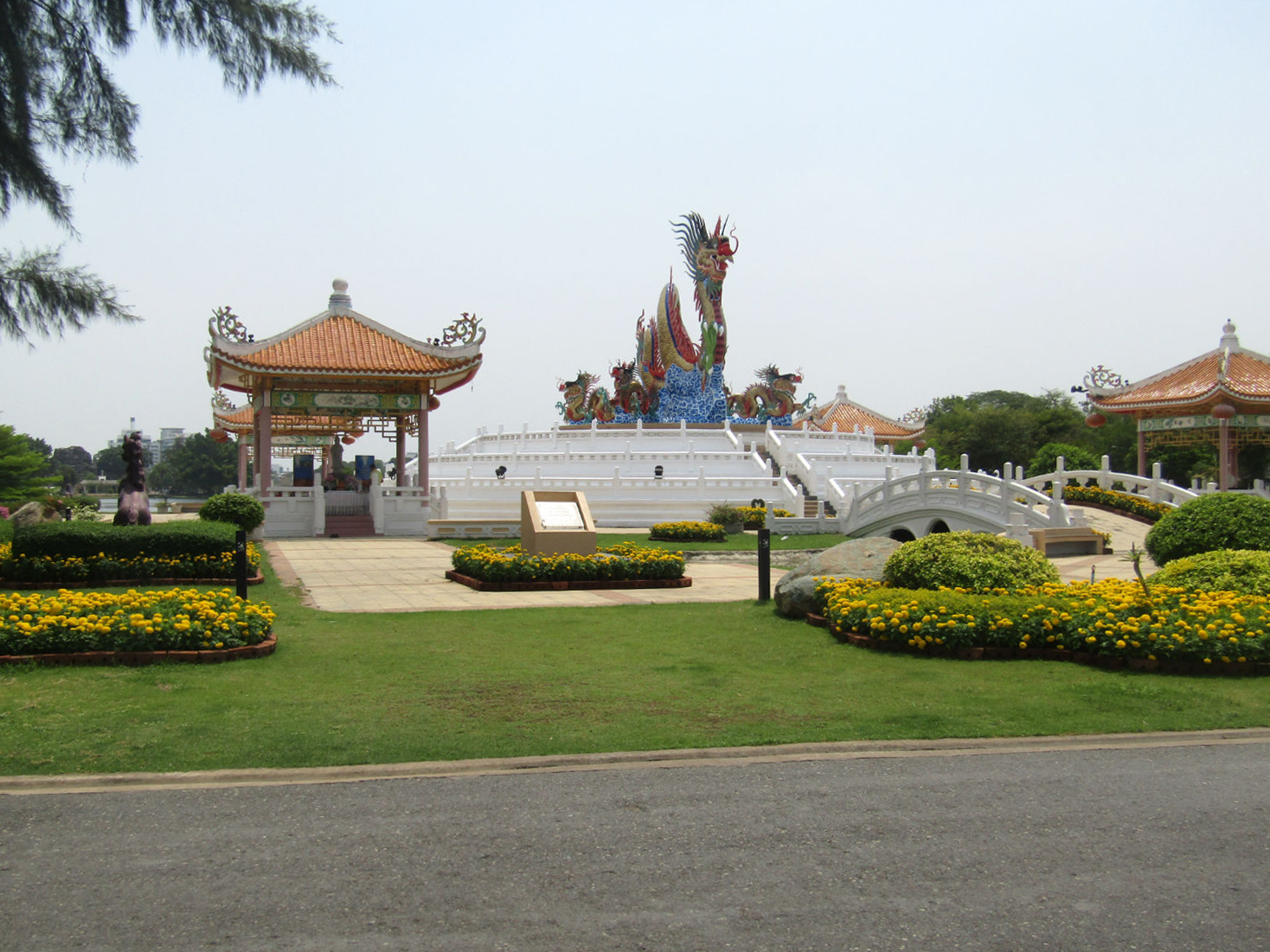
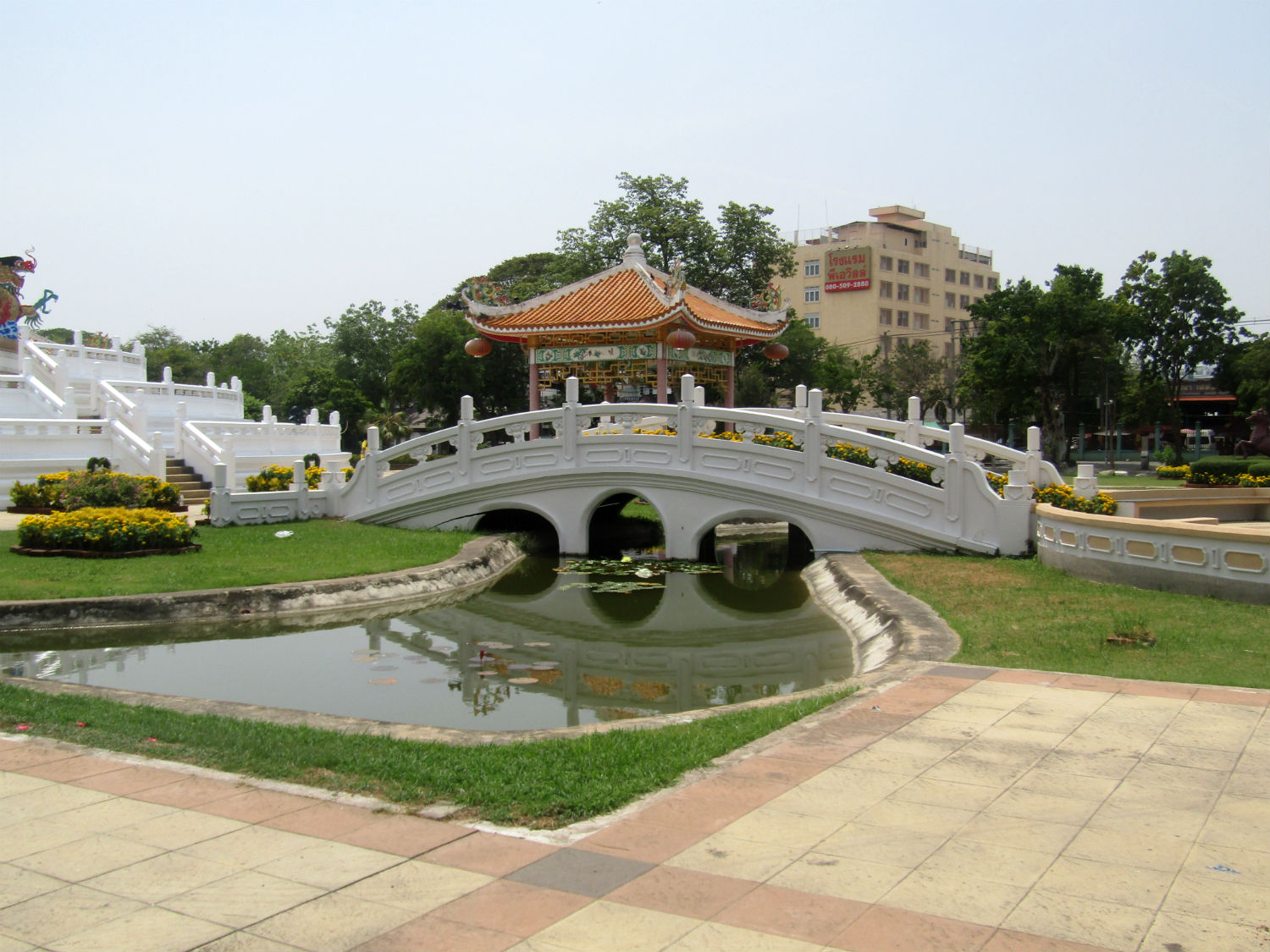
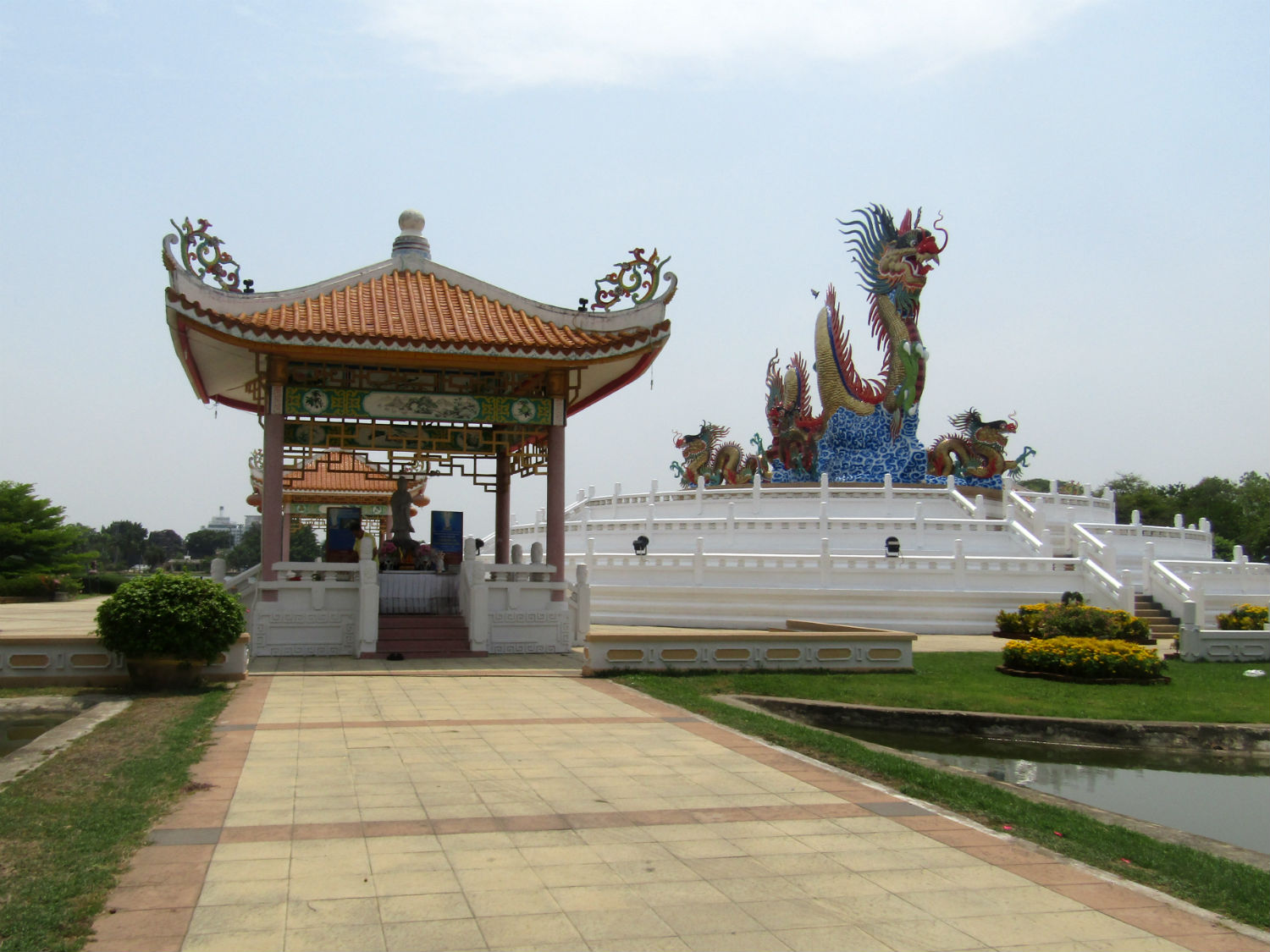
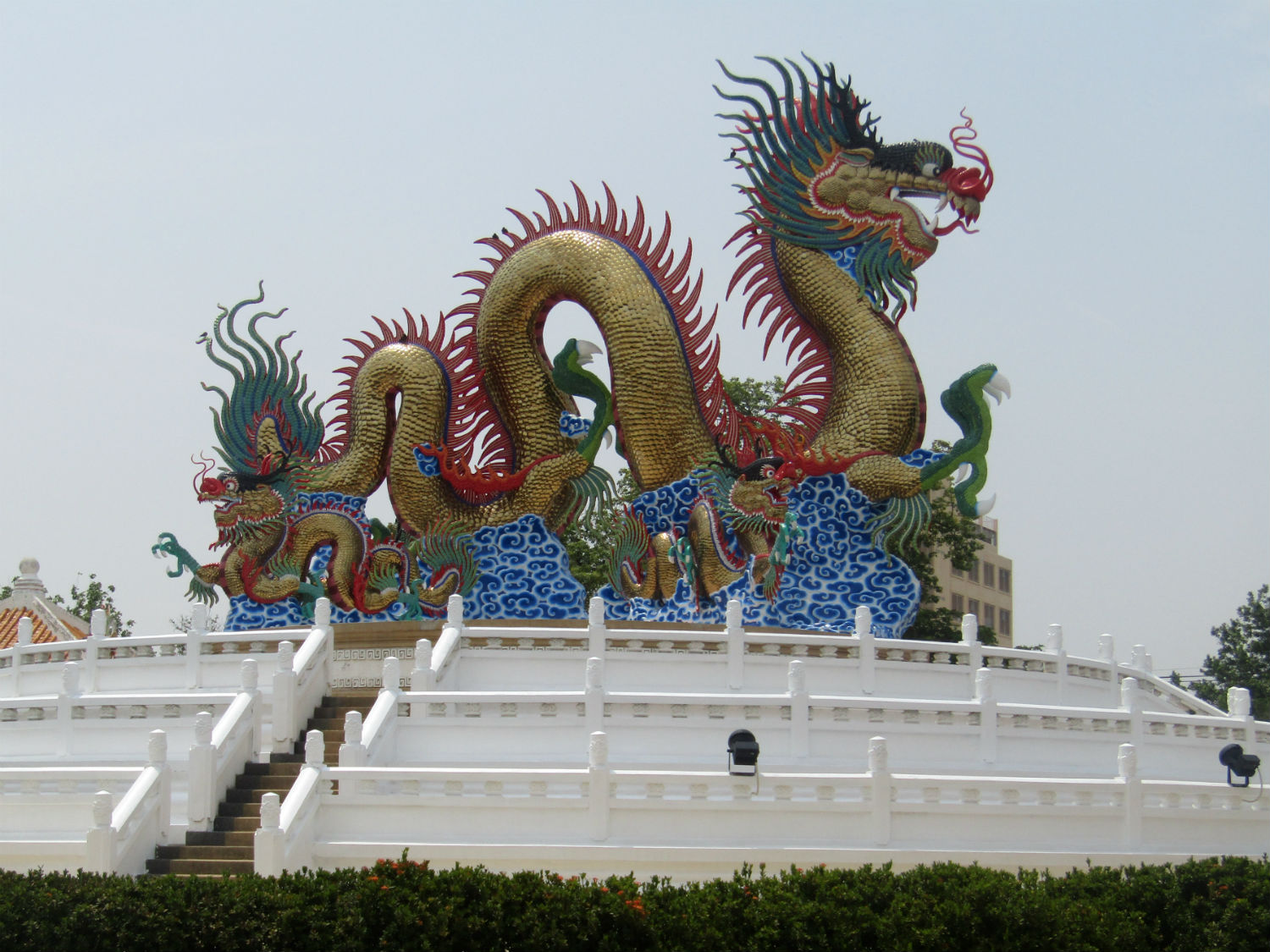
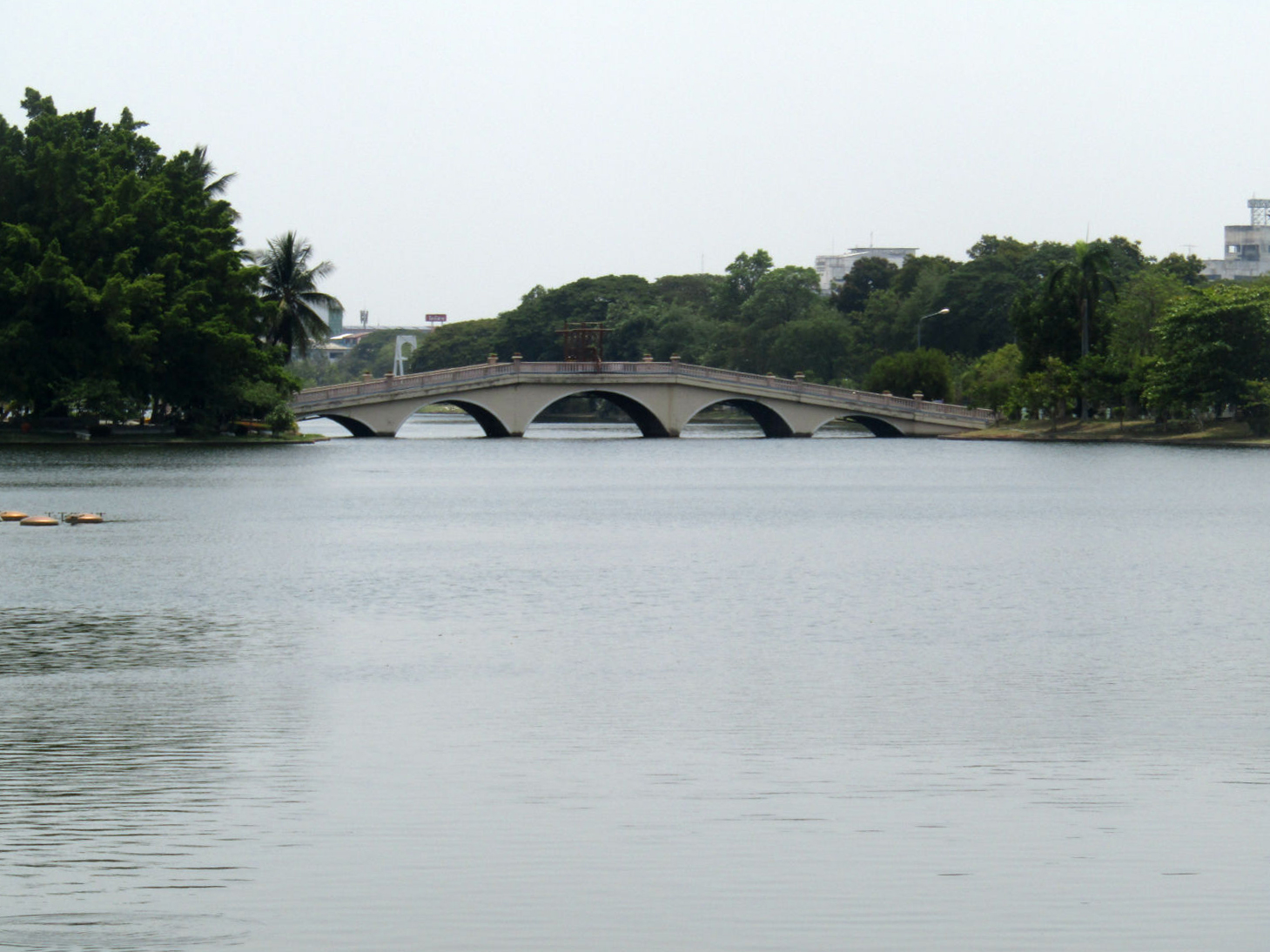
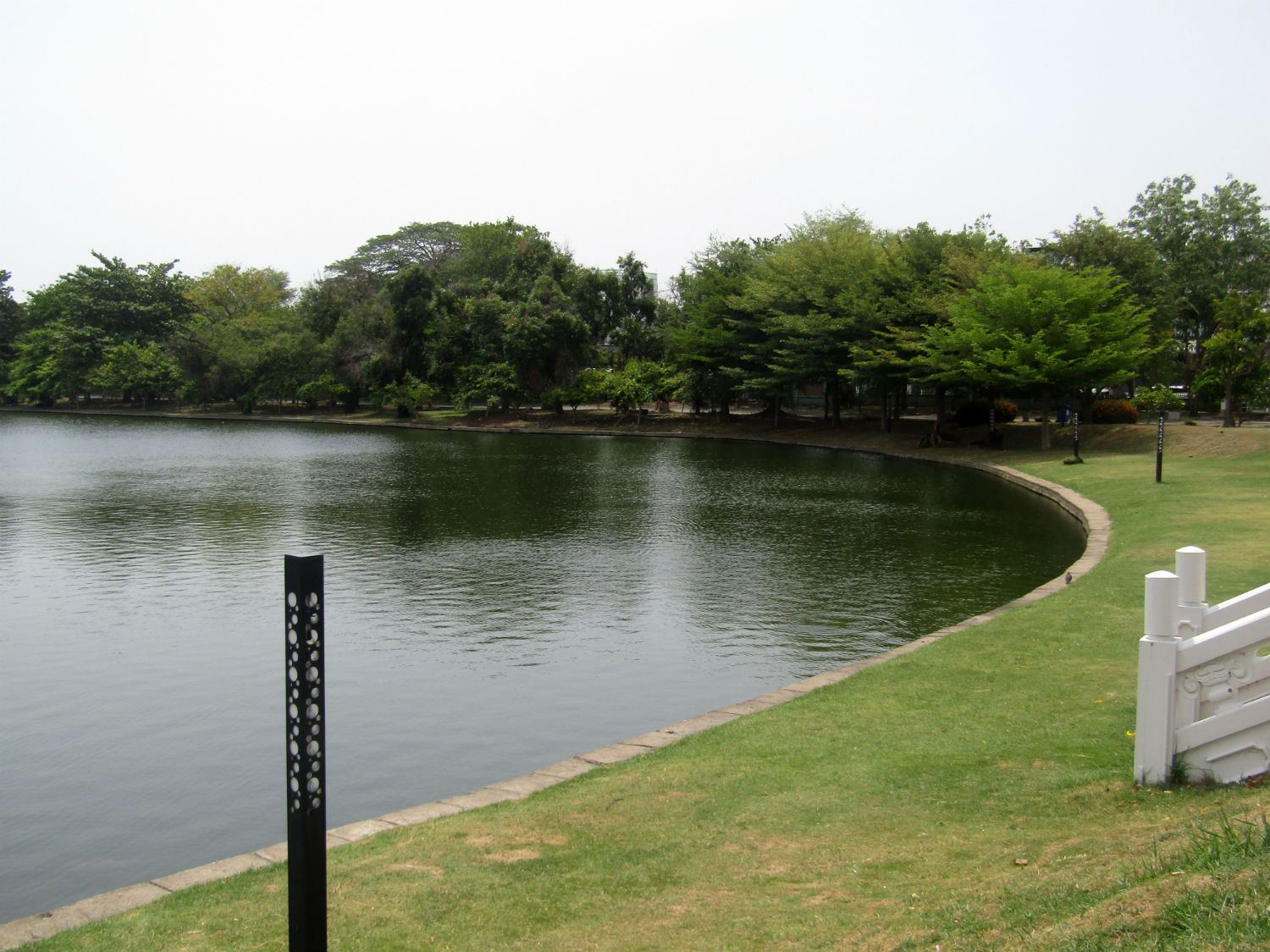 Paradise Park, Mueang Nakhon Sawan, Nakhon Sawan Province
Paradise Park, Mueang Nakhon Sawan, Nakhon Sawan Province
Fairyland Plaza……..
Fairyland Plaza is on Katoon’s list not mine and as we arrive I mutter, ‘what on earth are we doing in a shopping centre?’ Parking up on the 3rd floor of the car park, we enter the centre and take the lift to the 5th floor. Here Katoon explains is a museum. This I have to see noting that the shopping centre itself could well qualify in the near future as vintage. Sure enough you could call this a museum but the majority of exhibits, nicely classified according to function and use, are vintage 20th century. The old jukebox for instance makes me feel really old. It’s amazing how in a person’s lifetime how many thing have fallen out of use. The presentation in a series of compartments is contemporary with Thai/Chinese life in Nakhon Sawan over the years but many of the objects will be familiar of older members of any nationality.
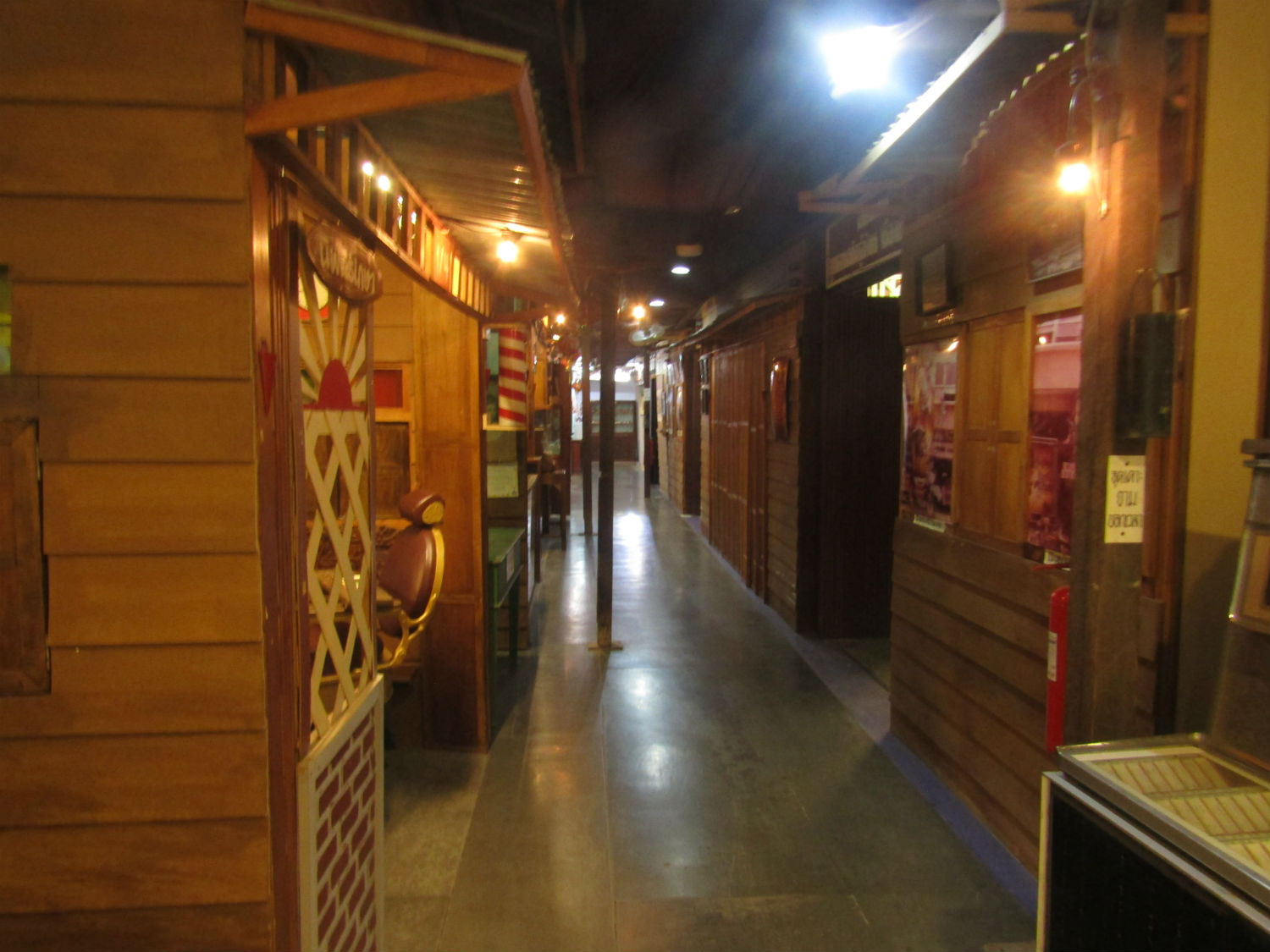
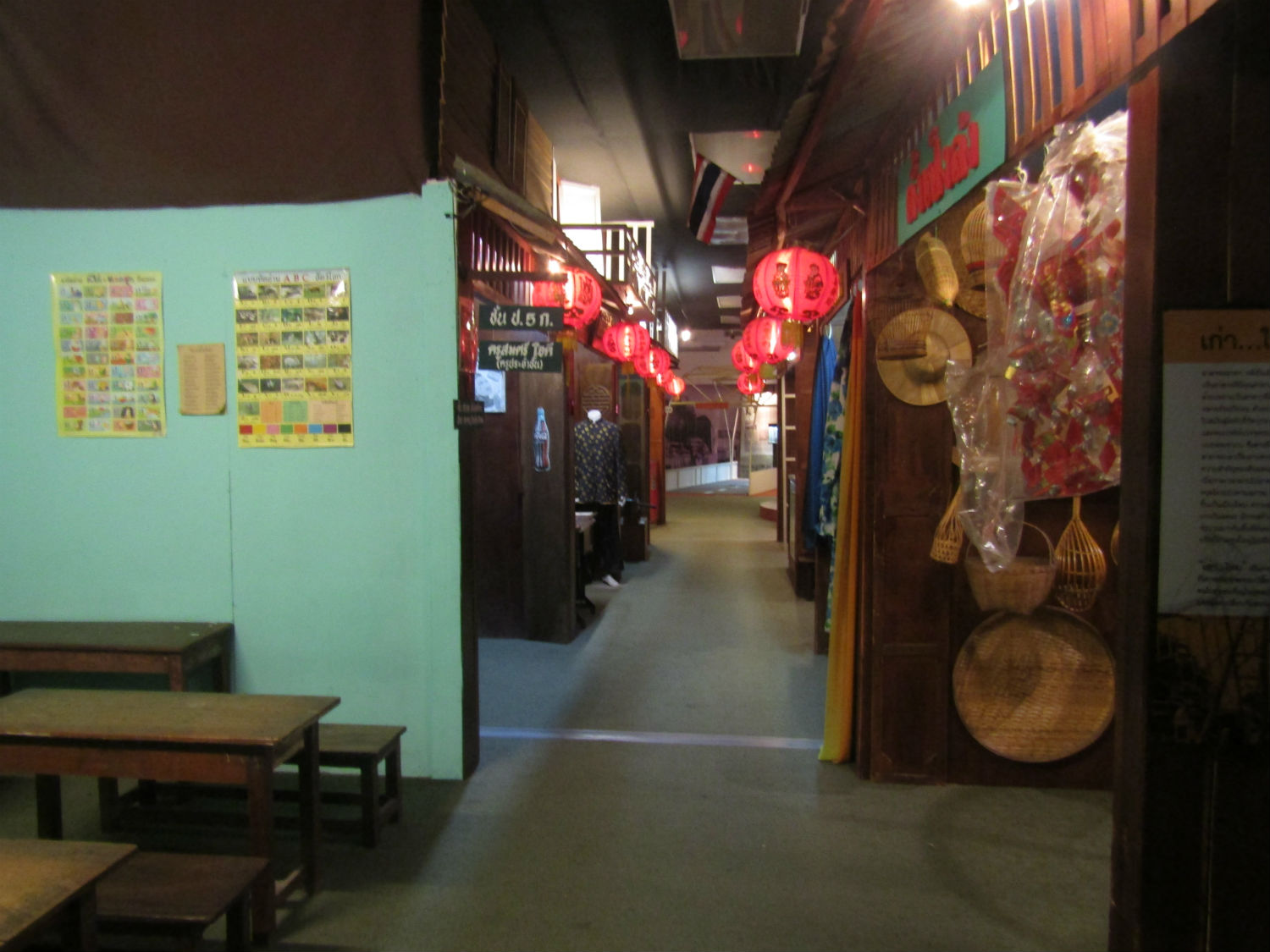
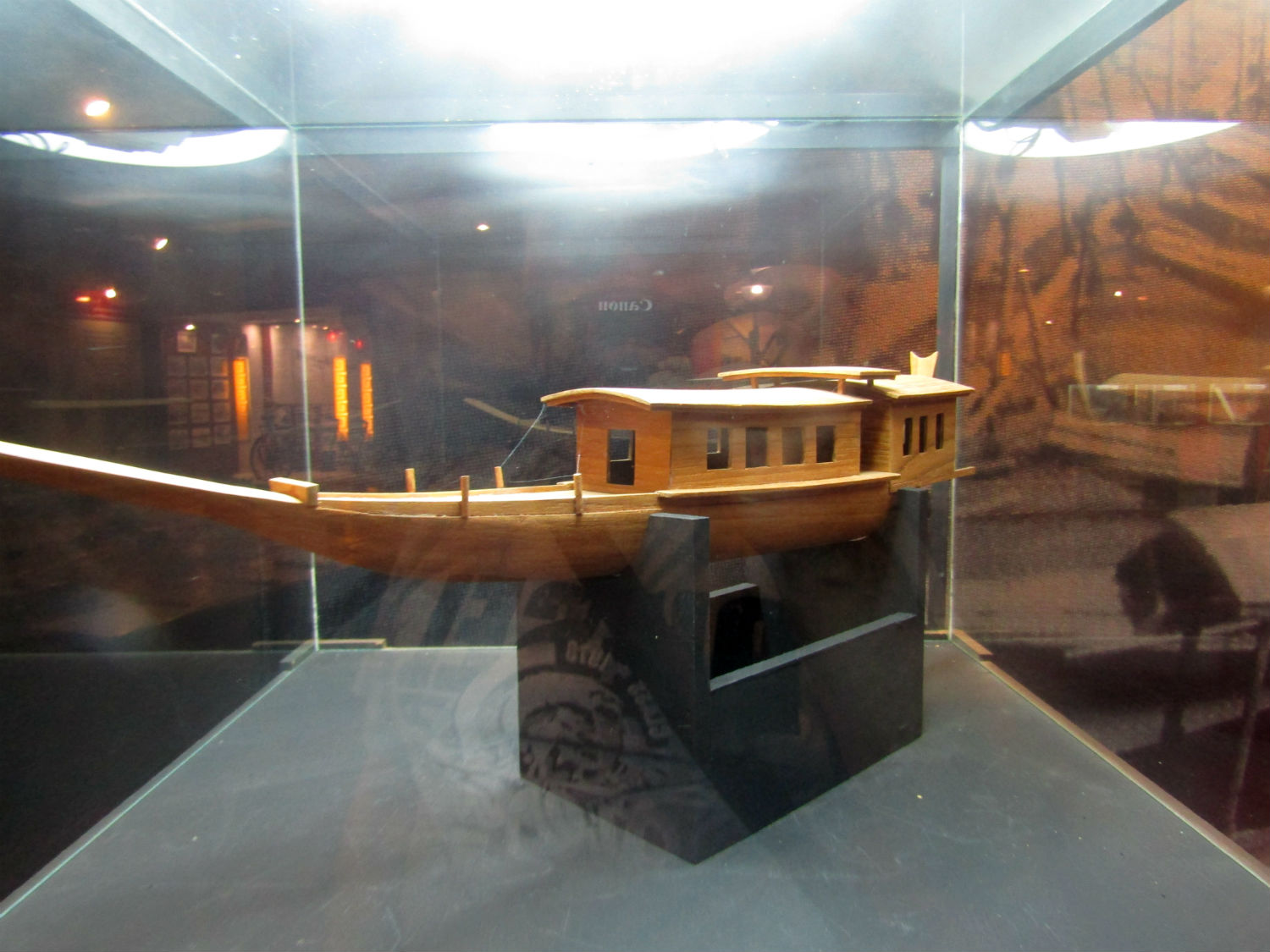
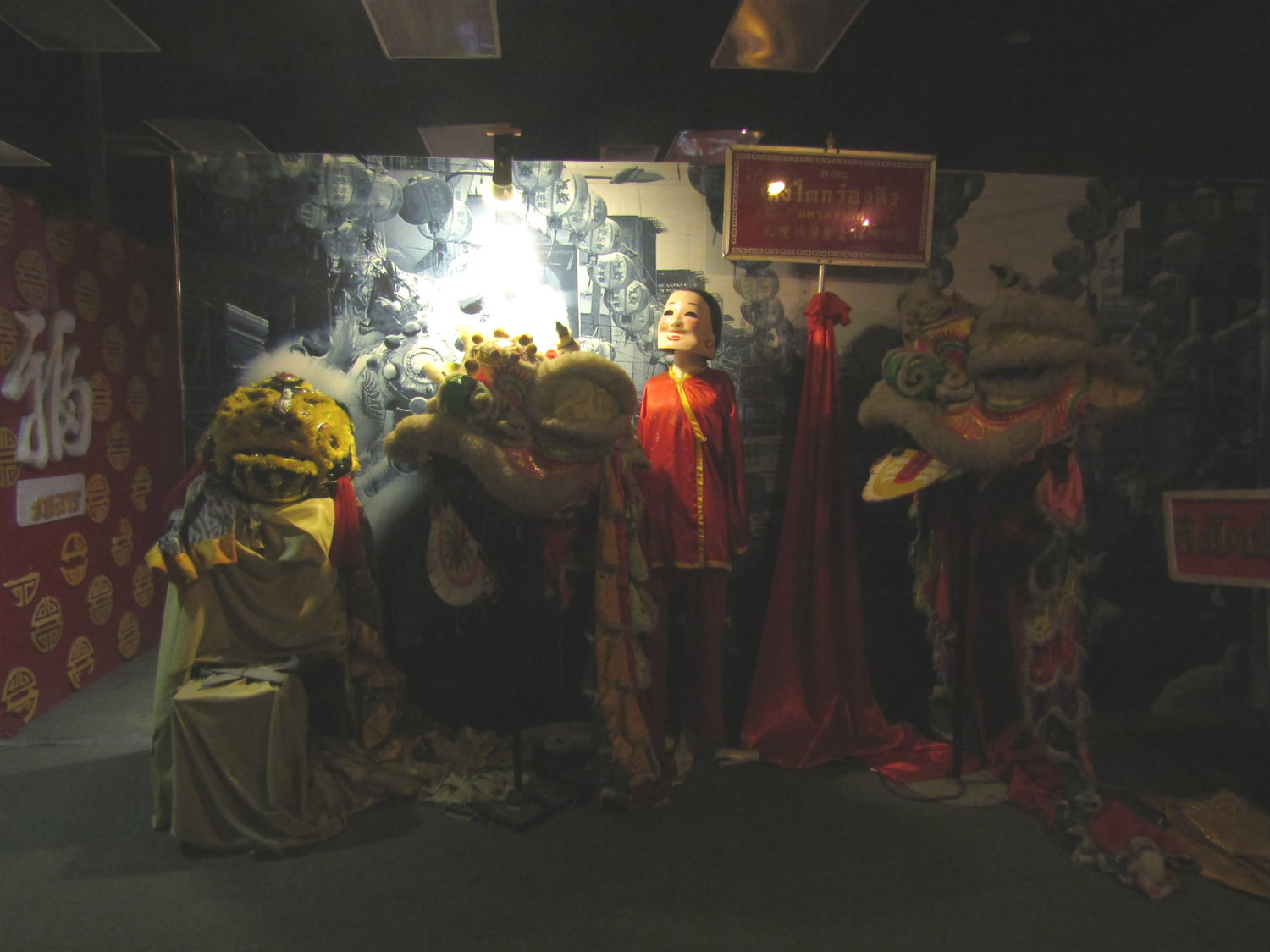

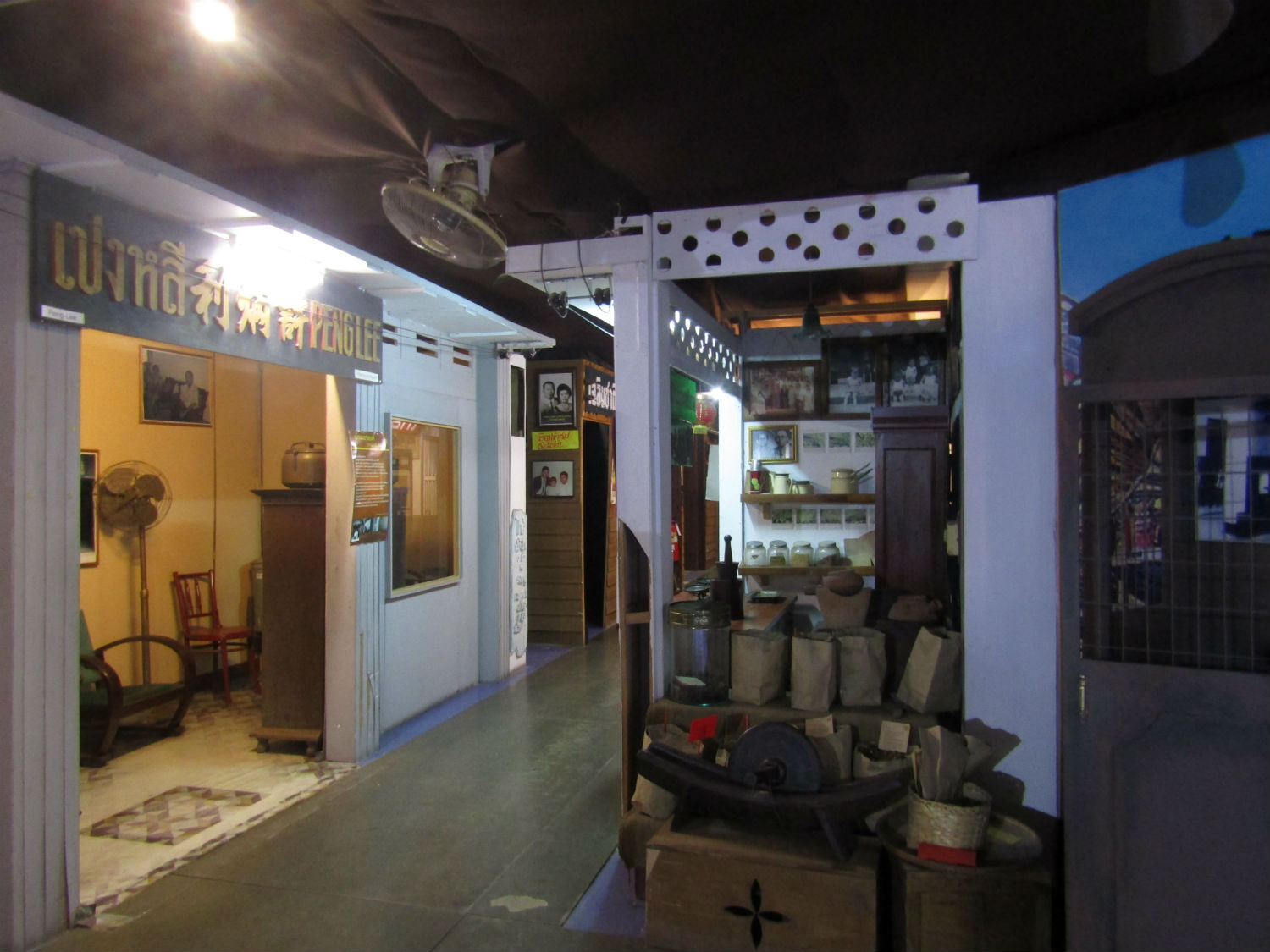 Fairyland Plaza, Mueang Nakhon Sawan, Nakhon Sawan Province
Fairyland Plaza, Mueang Nakhon Sawan, Nakhon Sawan Province
Thankfully a visit to this cultural museum is the only reason to be here but despite being around 11am we may as well get something to eat in the food court in more pleasant conditions than we might expect later on. Besides, breakfast was pretty basic.
Wat Woranat Ban Phot (Khao Kob)…….. Wat Woranat Ban Phot is located in the old quarter of the city. A chedi and viharn were first constructed here between 1359 and 1361 in the Sukhothai art style. Pot shards from the Sukhothai kilns have been recovered as well as pottery dating up to the late Ayutthaya period suggesting continued use of the temple for at least 400 years. However, following the sack of Ayutthaya, the temple fell into disuse. More than a century later a monk called Luang Pu Tong was invited to renovate the temple bringing it back into use for the community once more.
Wat Woranat Ban Phot was listed as an ancient monument in 1935.
Wat Woranat Ban Phot (Khao Kob)…….. Wat Woranat Ban Phot is located in the old quarter of the city. A chedi and viharn were first constructed here between 1359 and 1361 in the Sukhothai art style. Pot shards from the Sukhothai kilns have been recovered as well as pottery dating up to the late Ayutthaya period suggesting continued use of the temple for at least 400 years. However, following the sack of Ayutthaya, the temple fell into disuse. More than a century later a monk called Luang Pu Tong was invited to renovate the temple bringing it back into use for the community once more.
Wat Woranat Ban Phot was listed as an ancient monument in 1935.
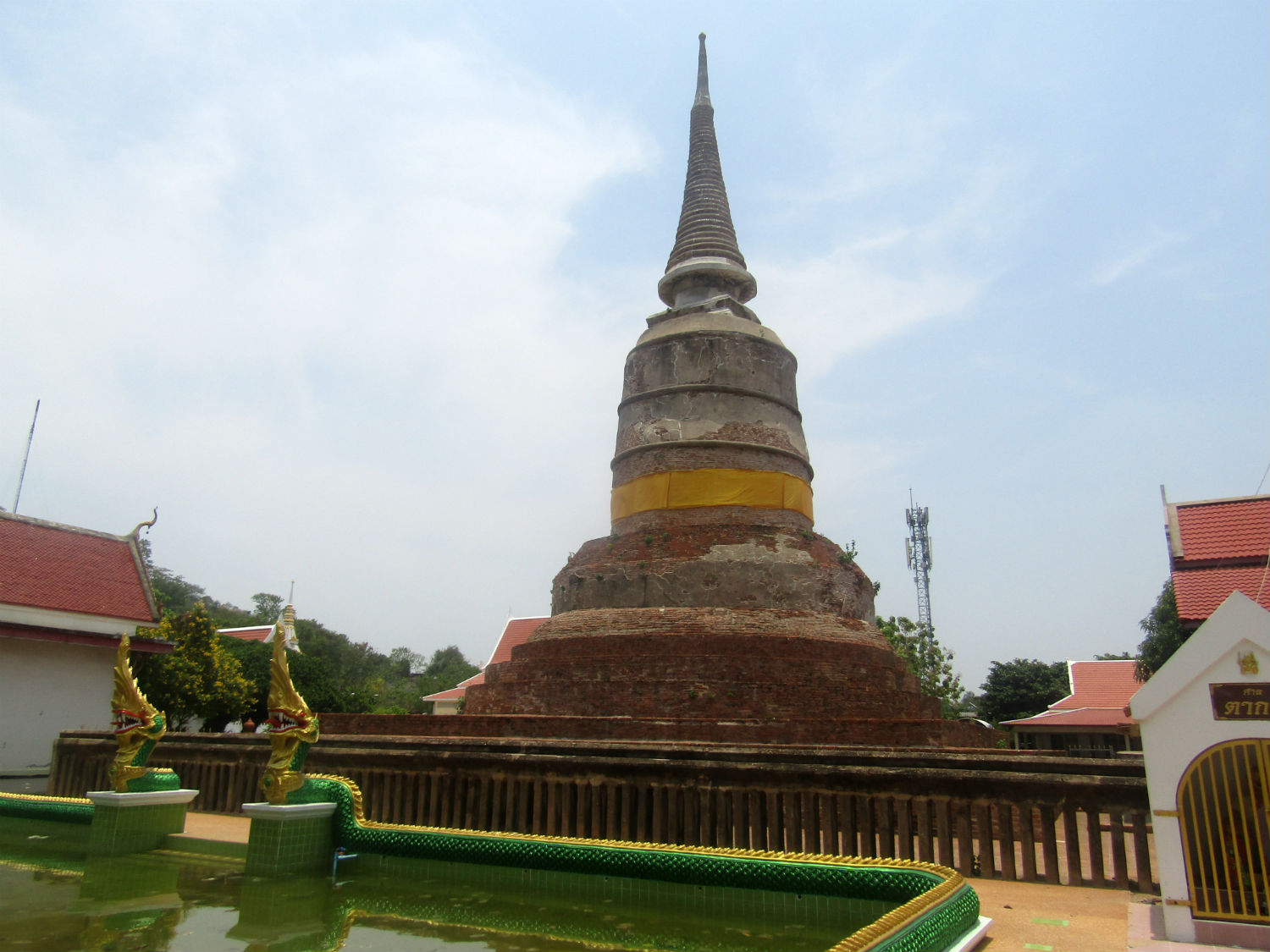
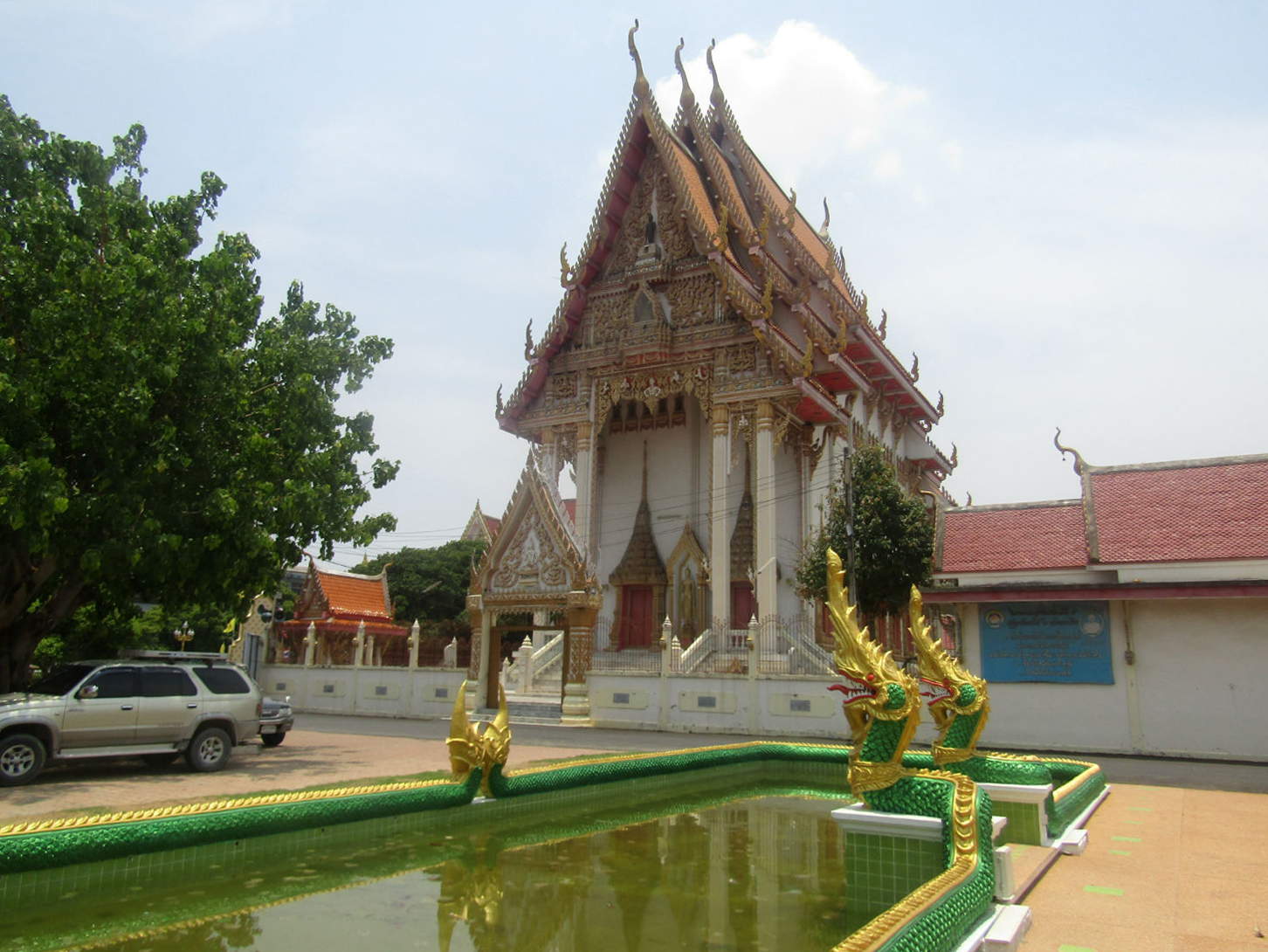
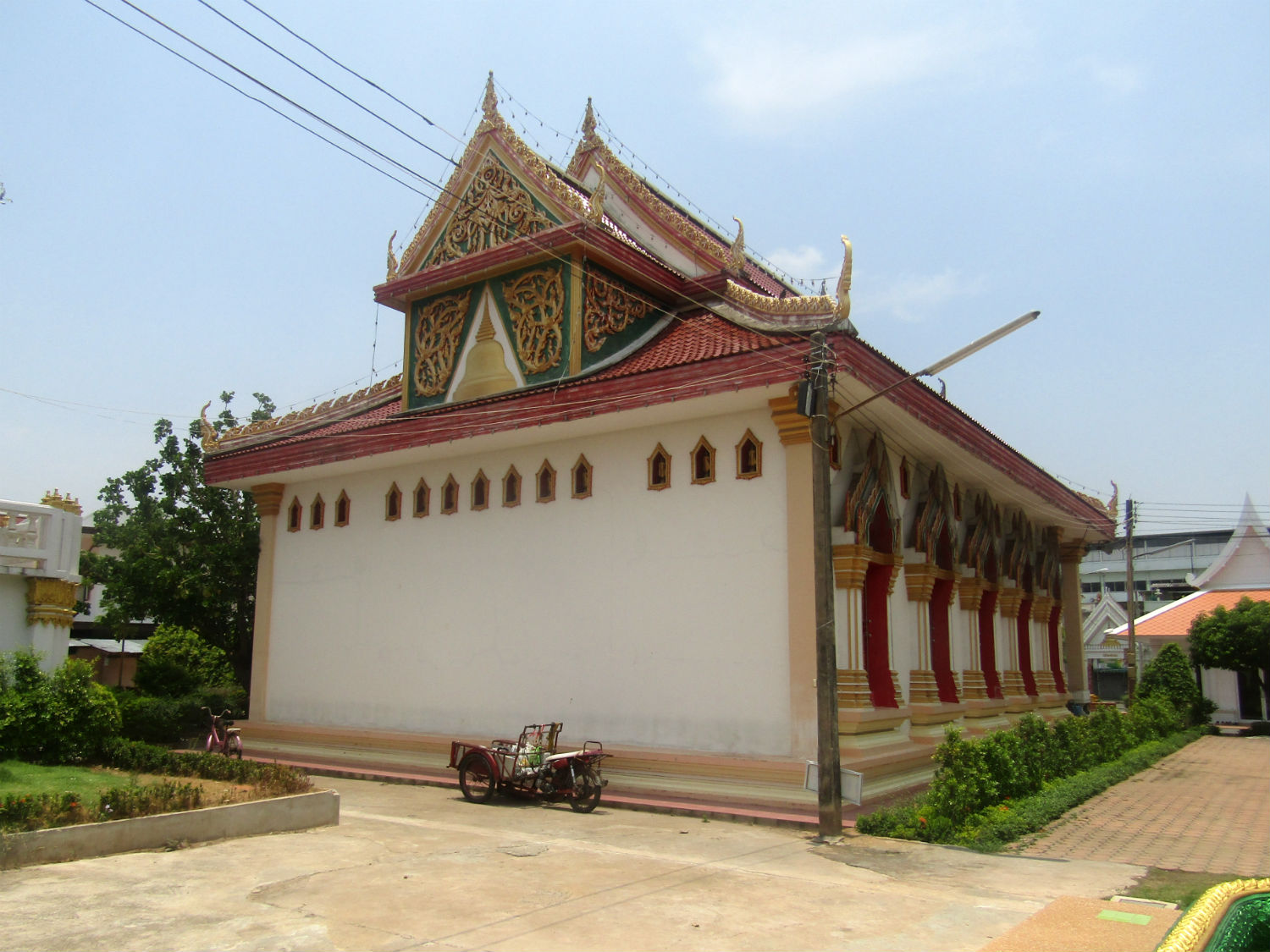
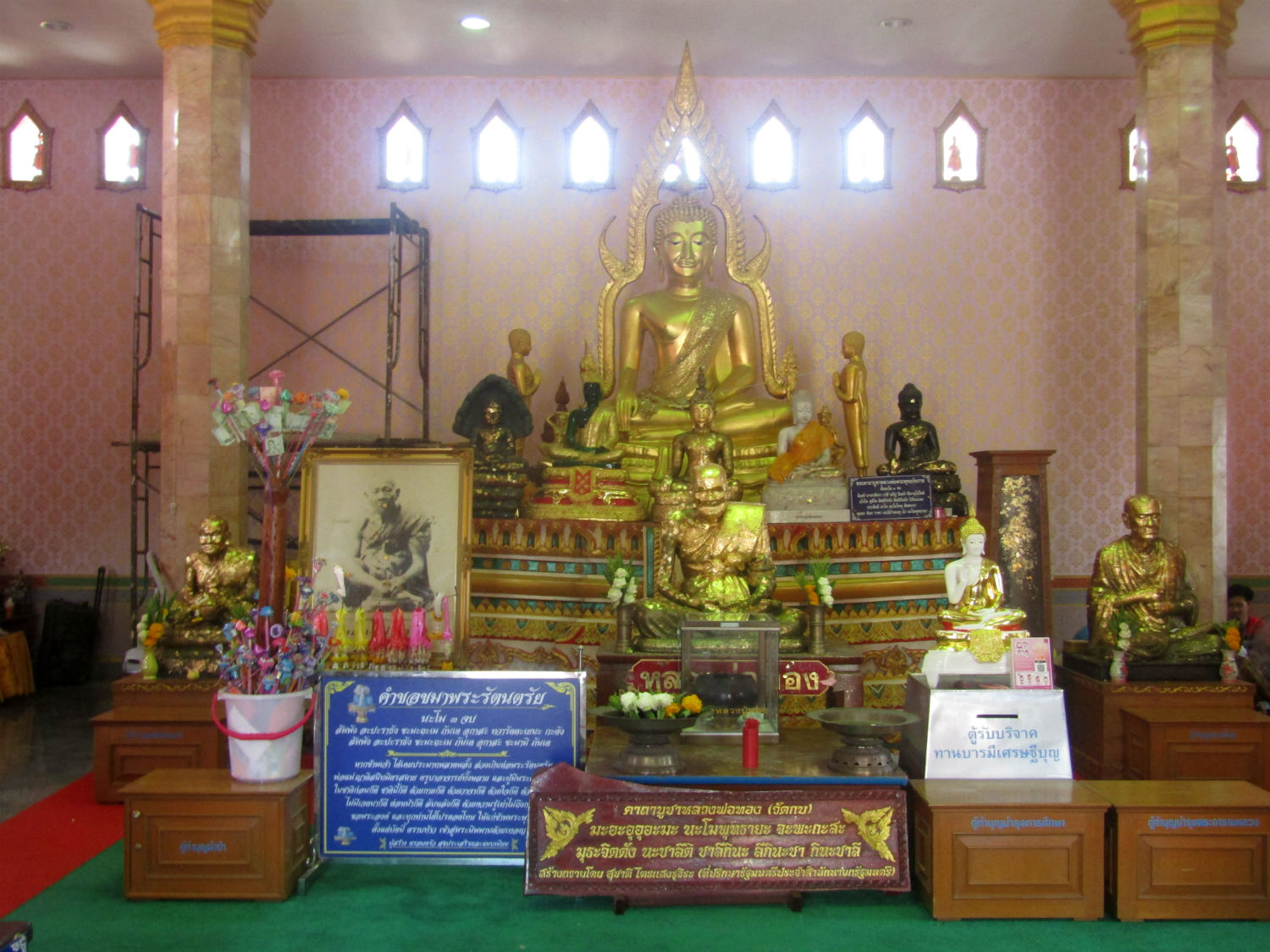
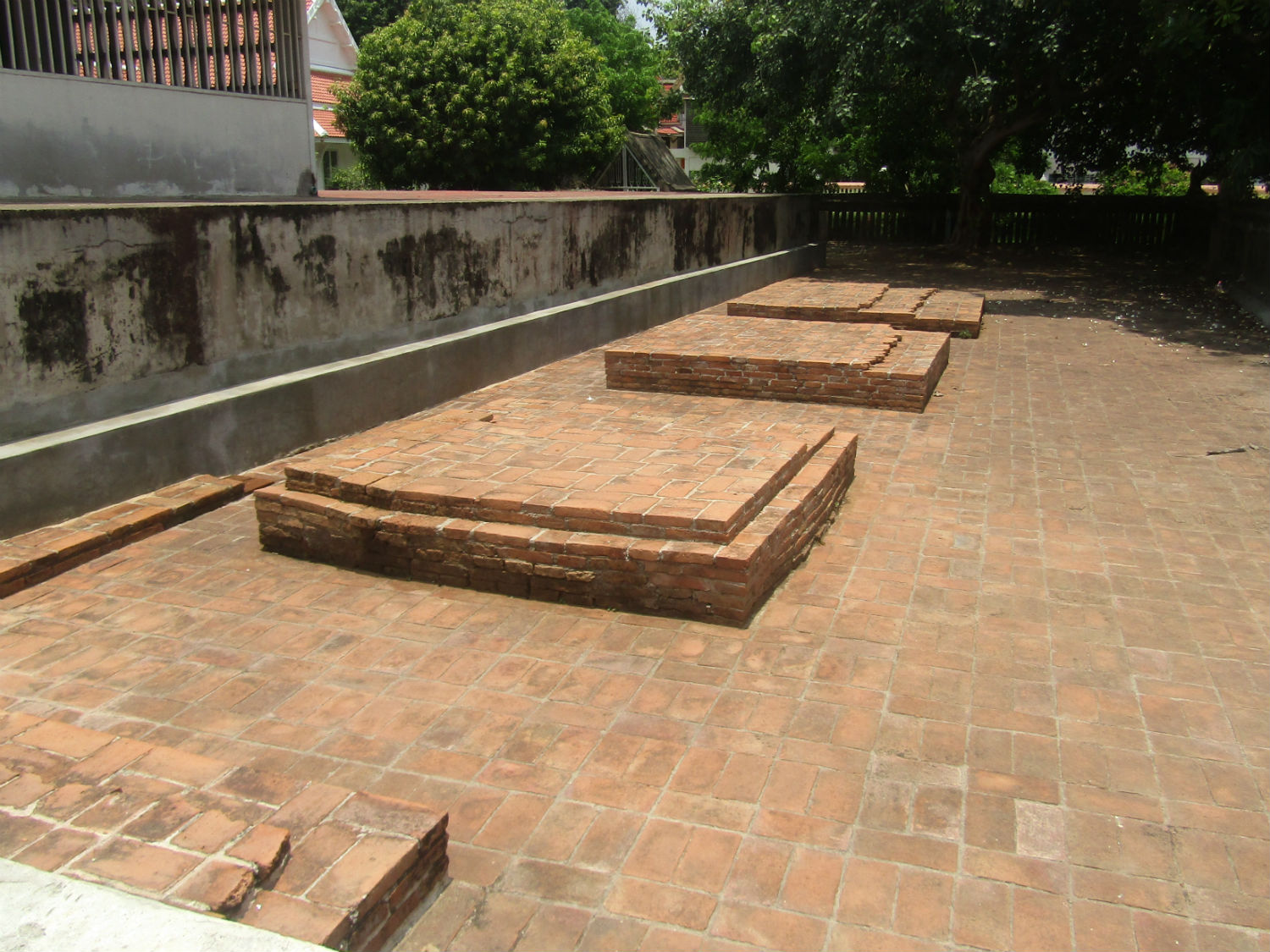
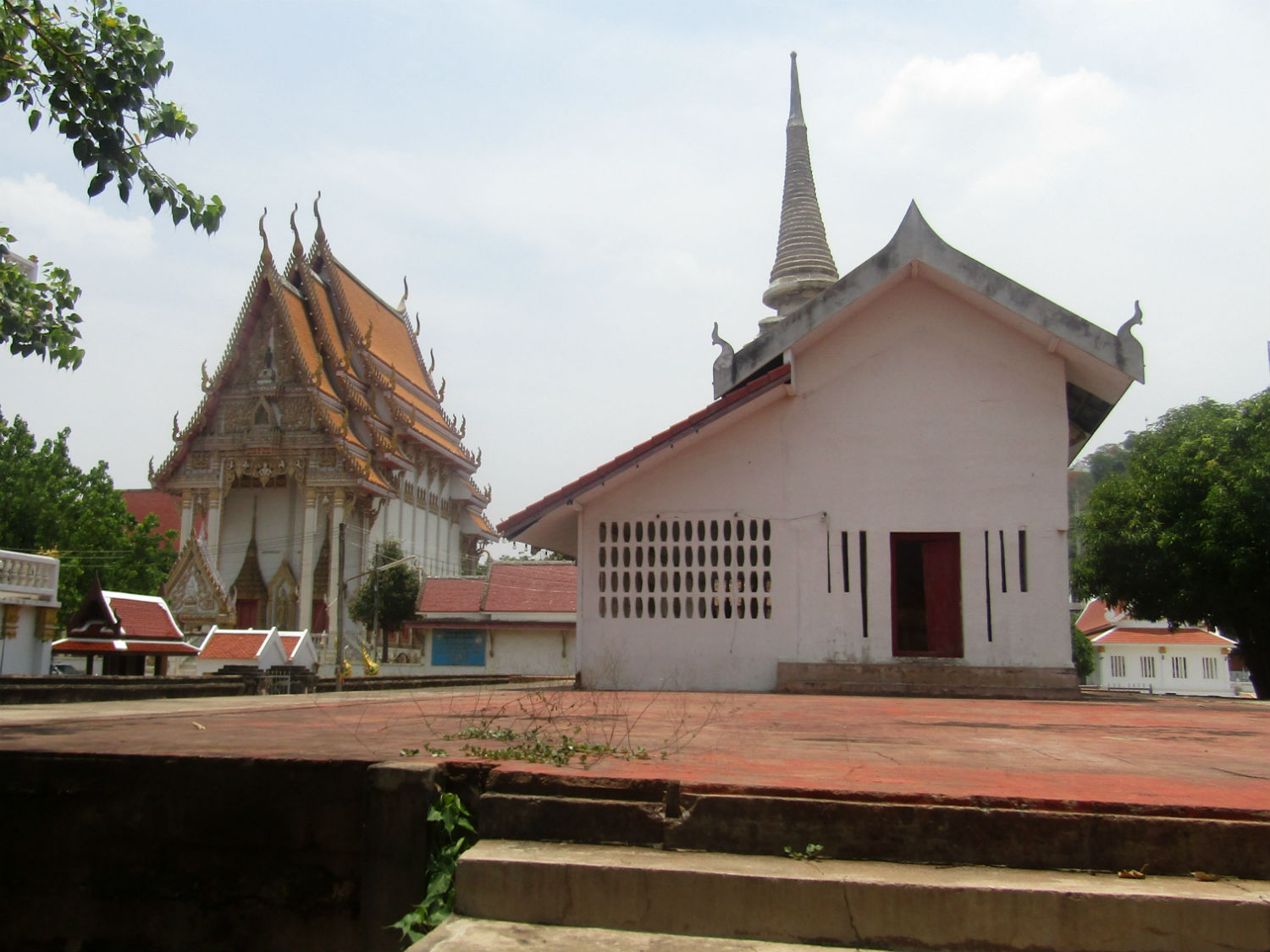 Wat Woranat Ban Phot (Khao Kob), Mueang Nakhon Sawan, Nakhon Sawan Province
Wat Woranat Ban Phot (Khao Kob), Mueang Nakhon Sawan, Nakhon Sawan Province
Chao Por Chao Na Pha Shrine……..
The Chao Por Chao Na Pha Shrine is located in the old city of Nakhon Sawan close to the Chao Phraya river bank where there is a strong Thai/Chinese community. This shrine is central to celebrations in Pak Nam Pho district during Chinese New Year when the annual contest to be Guan Yin, the Goddess of Compassion is chosen from the local virgin population.

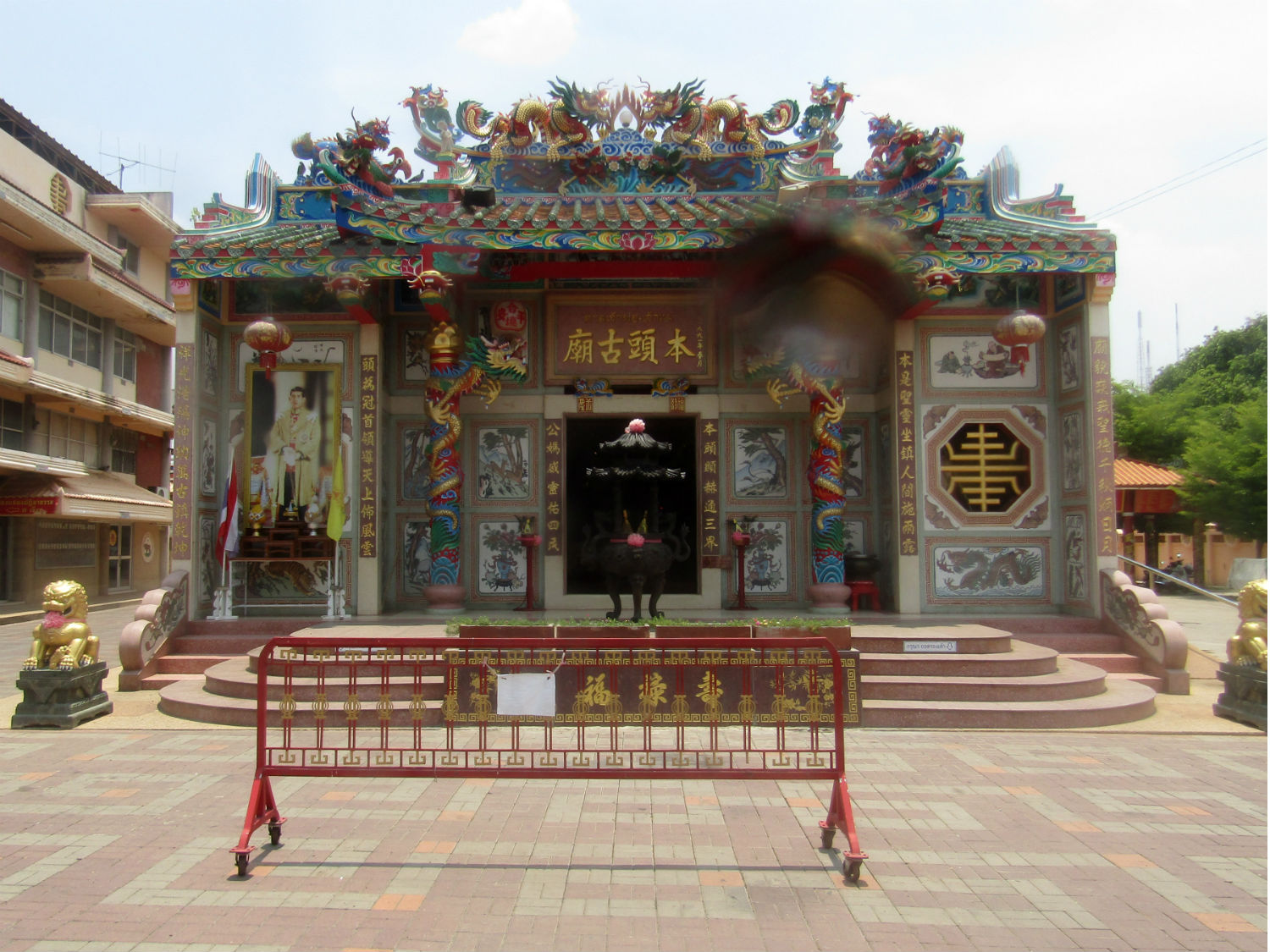
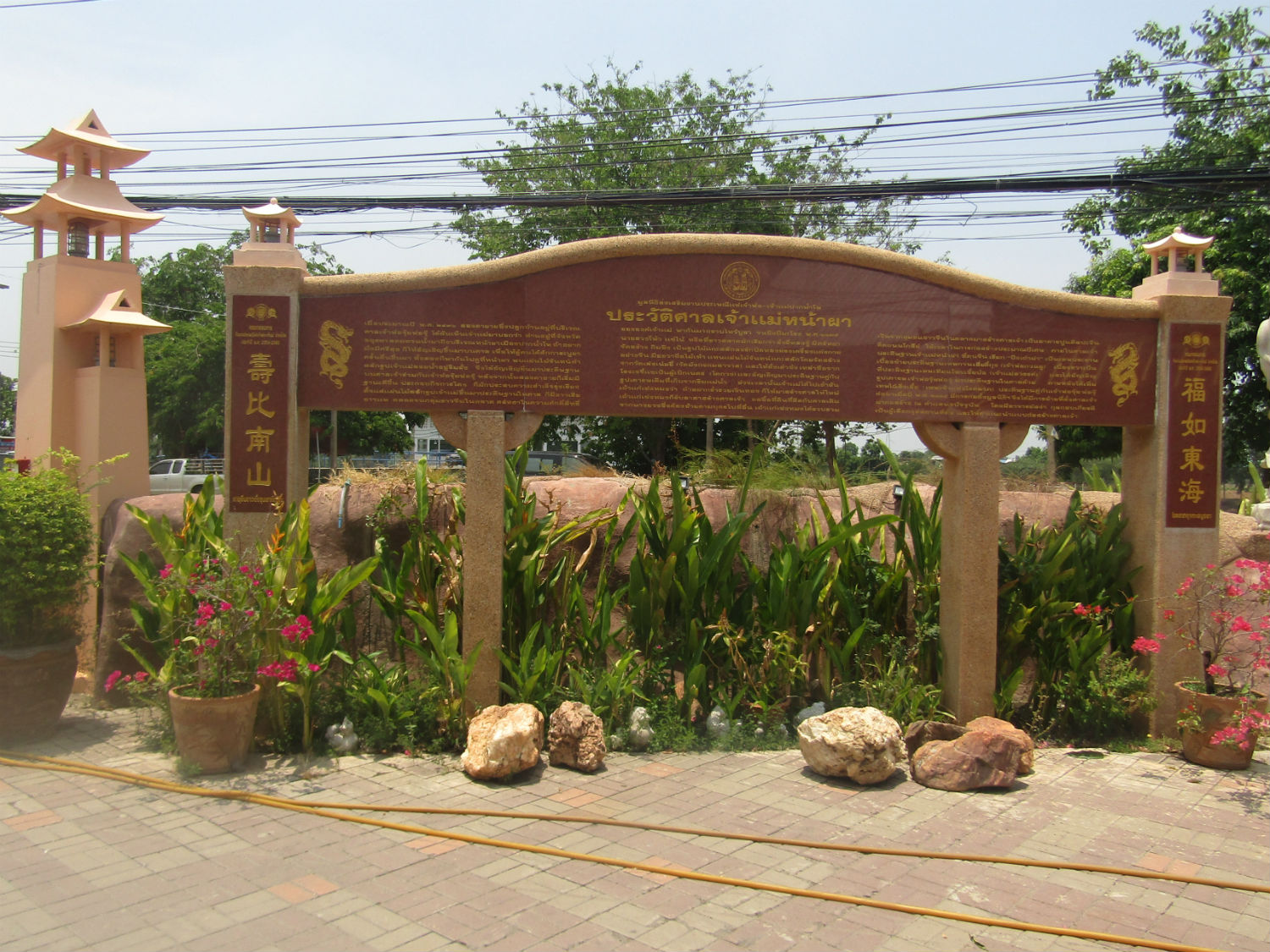 Chao Por Chao Na Pha Shrine, Mueang Nakhon Sawan, Nakhon Sawan Province
Chao Por Chao Na Pha Shrine, Mueang Nakhon Sawan, Nakhon Sawan Province
Chao Pho Theparak - Chao Mae Thapthim Shrine……..
Another important Thai/Chinese shrine can be found on the east bank of the Chao Phraya river practically opposite the convergence of the Ping and Nan rivers where we were yesterday during a thunderstorm. The original shrine was made of wood and had to be repaired many times but in 1899 a new shrine was built, part concrete part wood, in three sections. The new section at the front is dedicated to Tee Kong, the God of the sky. The middle section is still constructed of wood while the back section is newly renovated where Pun Tao Kong resides at the centre. To his left is Guan Yu and to his right is Chao Mae Thapthim. The roof is decorated with a couple of dragons raising a glass ball.

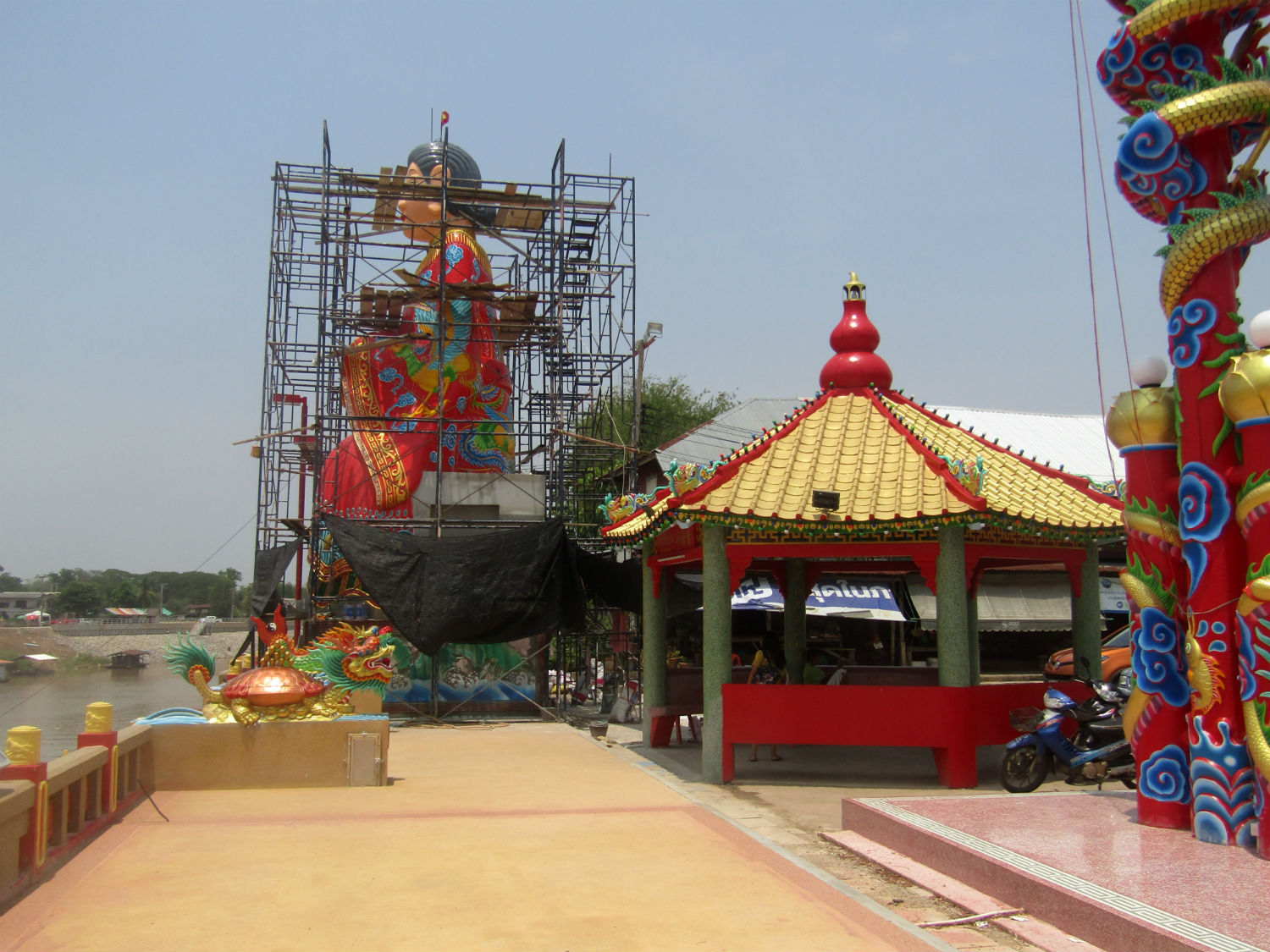
 Chao Pho Theparak - Chao Mae Thapthim Shrine, Mueang Nakhon Sawan, Nakhon Sawan Province
Chao Pho Theparak - Chao Mae Thapthim Shrine, Mueang Nakhon Sawan, Nakhon Sawan Province
Pak Nam Pho Railway Station……..
This railway station is just a few minutes from the Chao Pho Theparak Shrine near the Nan river. Fortunately today we locate it easily after making a ‘pig’s ear’ of it yesterday.
Pak Nam Pho railway station is a railway station in the Pak Nam Pho Sub-district, Nakhon Sawan City, Nakhon Sawan. It is 251 km from Bangkok railway station and is a class 1 railway station. It lies on the Northern Line of the State Railway of Thailand. The station opened on 31 October 1905 as part of the Northern Line extension from Lopburi to Pak Nam Pho. The line continued to Phitsanulok in 1908. Originally, this was the railway station for Nakhon Sawan City as passengers would alight here and cross the Chao Phraya River to reach the city, however its main purpose was removed as the new railway station built at Nong Pling replaced its role. Today, the station acts as a rail yard, a railway maintenance centre, and a junction for an occasionally-used freight line to Kamnansong Rice Mill. There are 8 services per day passing through this station.
Fortunately, when I was expecting no activity at this station, there was an Alsthom locomotive in the maintenance centre and a newly arrived GE locomotive in the sidings.
Pak Nam Pho railway station is a railway station in the Pak Nam Pho Sub-district, Nakhon Sawan City, Nakhon Sawan. It is 251 km from Bangkok railway station and is a class 1 railway station. It lies on the Northern Line of the State Railway of Thailand. The station opened on 31 October 1905 as part of the Northern Line extension from Lopburi to Pak Nam Pho. The line continued to Phitsanulok in 1908. Originally, this was the railway station for Nakhon Sawan City as passengers would alight here and cross the Chao Phraya River to reach the city, however its main purpose was removed as the new railway station built at Nong Pling replaced its role. Today, the station acts as a rail yard, a railway maintenance centre, and a junction for an occasionally-used freight line to Kamnansong Rice Mill. There are 8 services per day passing through this station.
Fortunately, when I was expecting no activity at this station, there was an Alsthom locomotive in the maintenance centre and a newly arrived GE locomotive in the sidings.

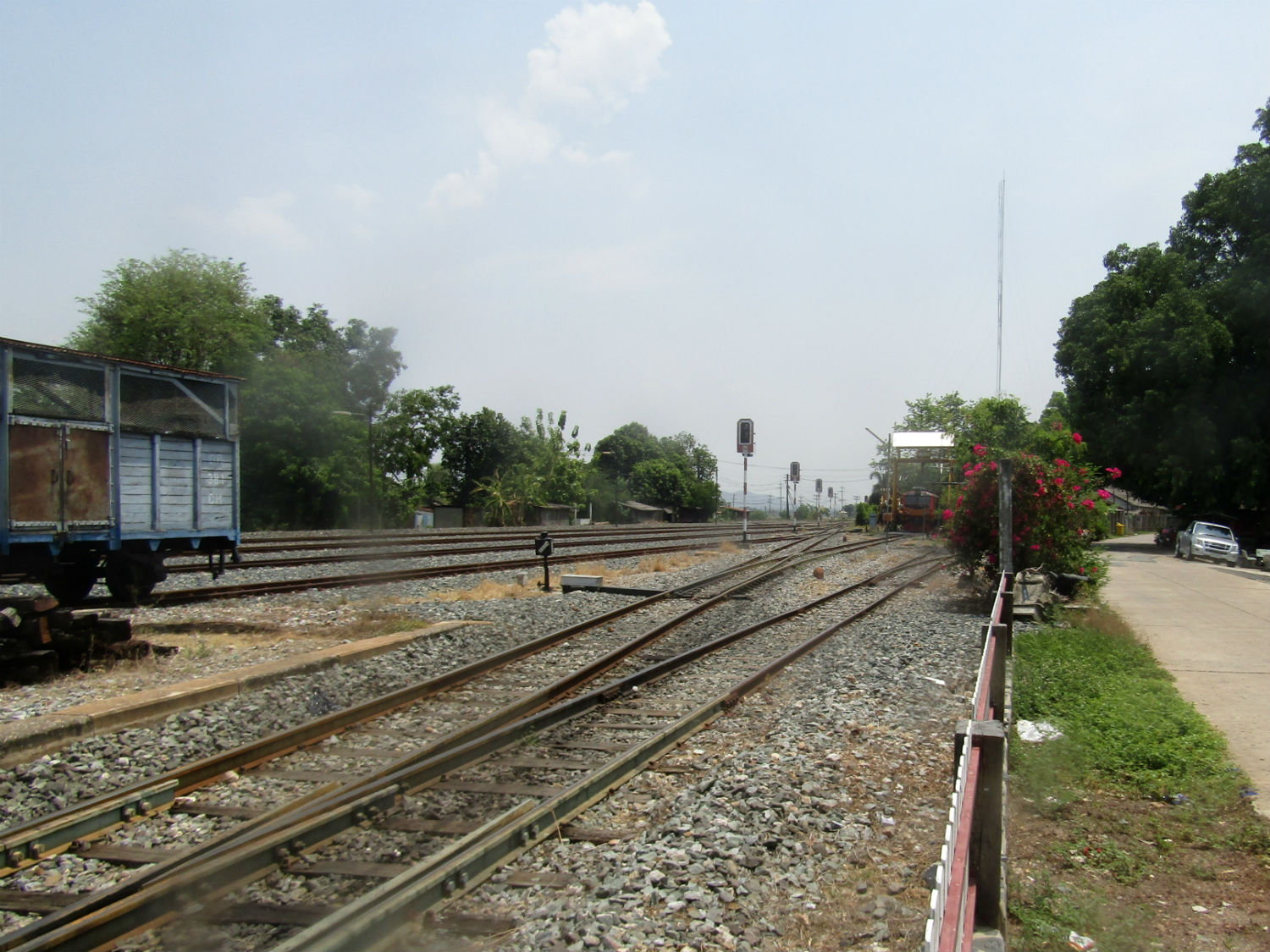
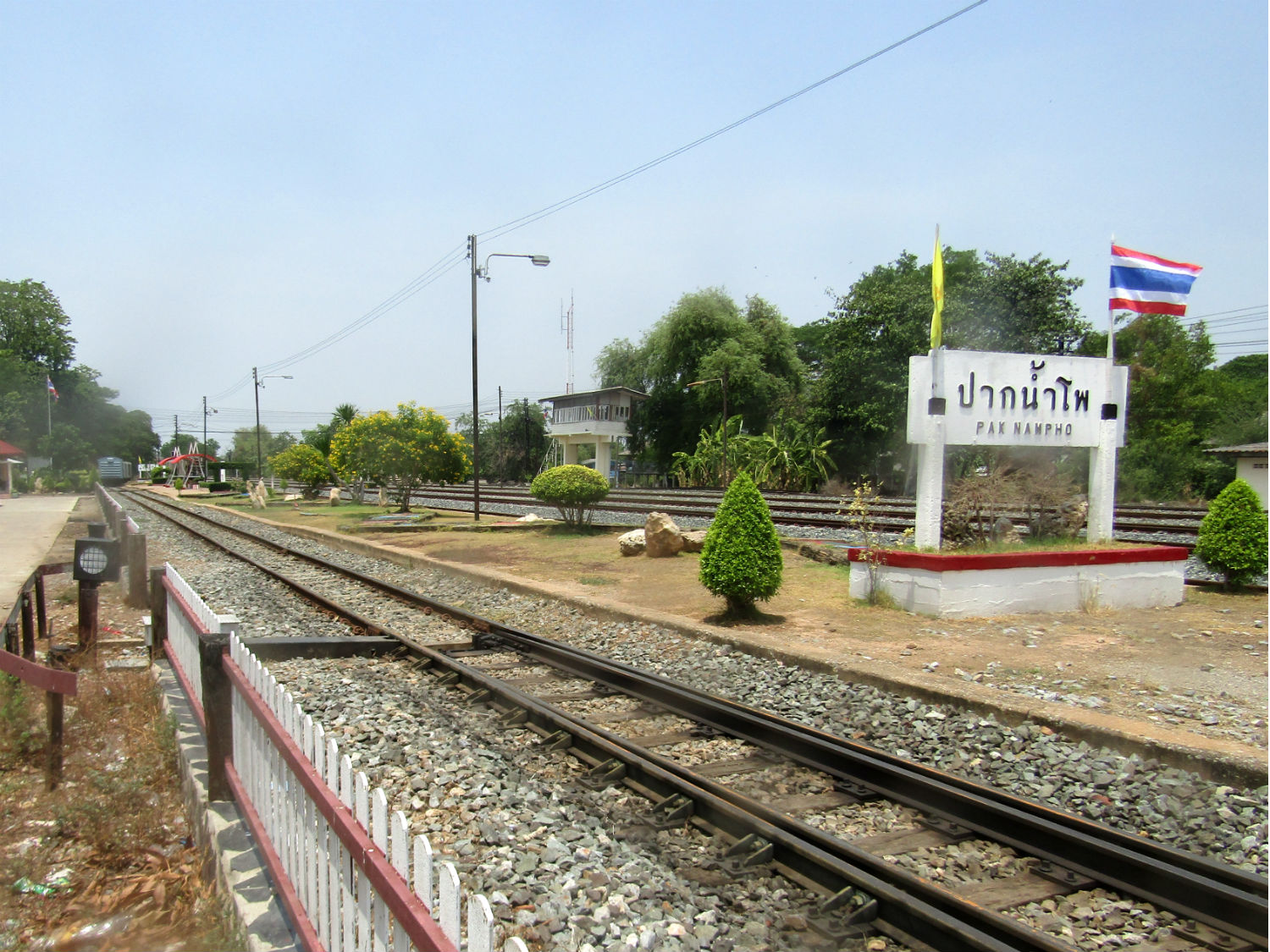
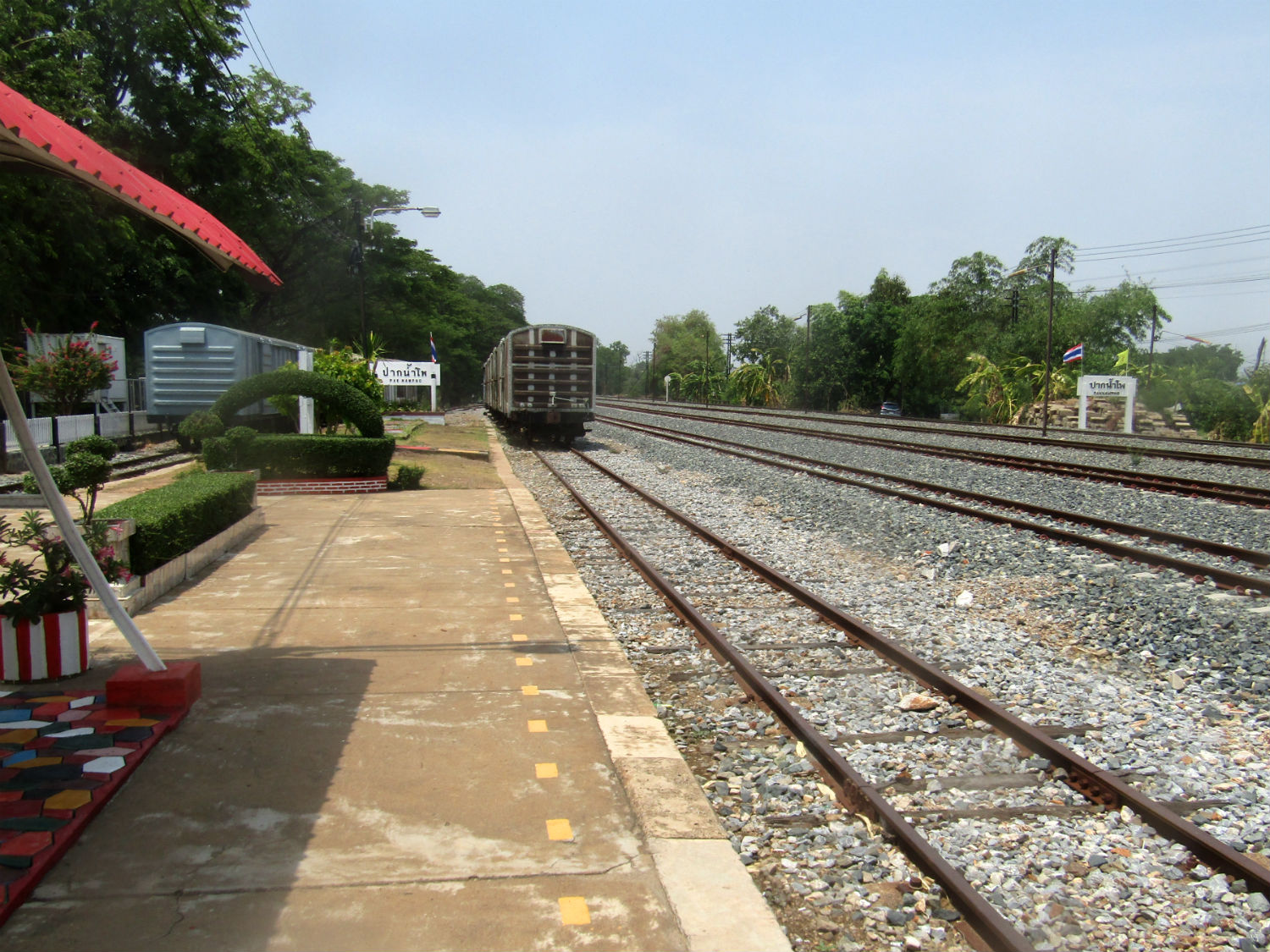


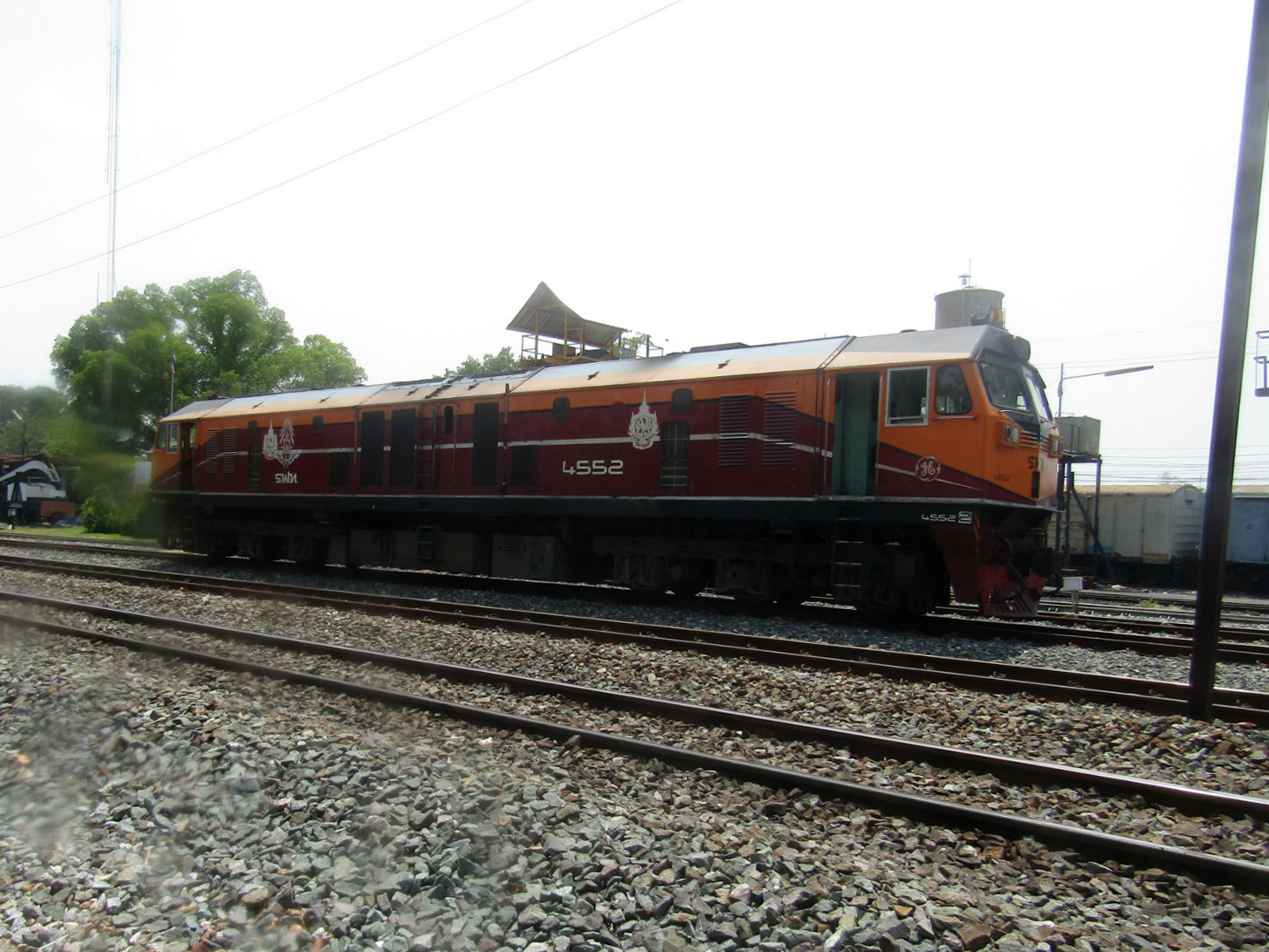
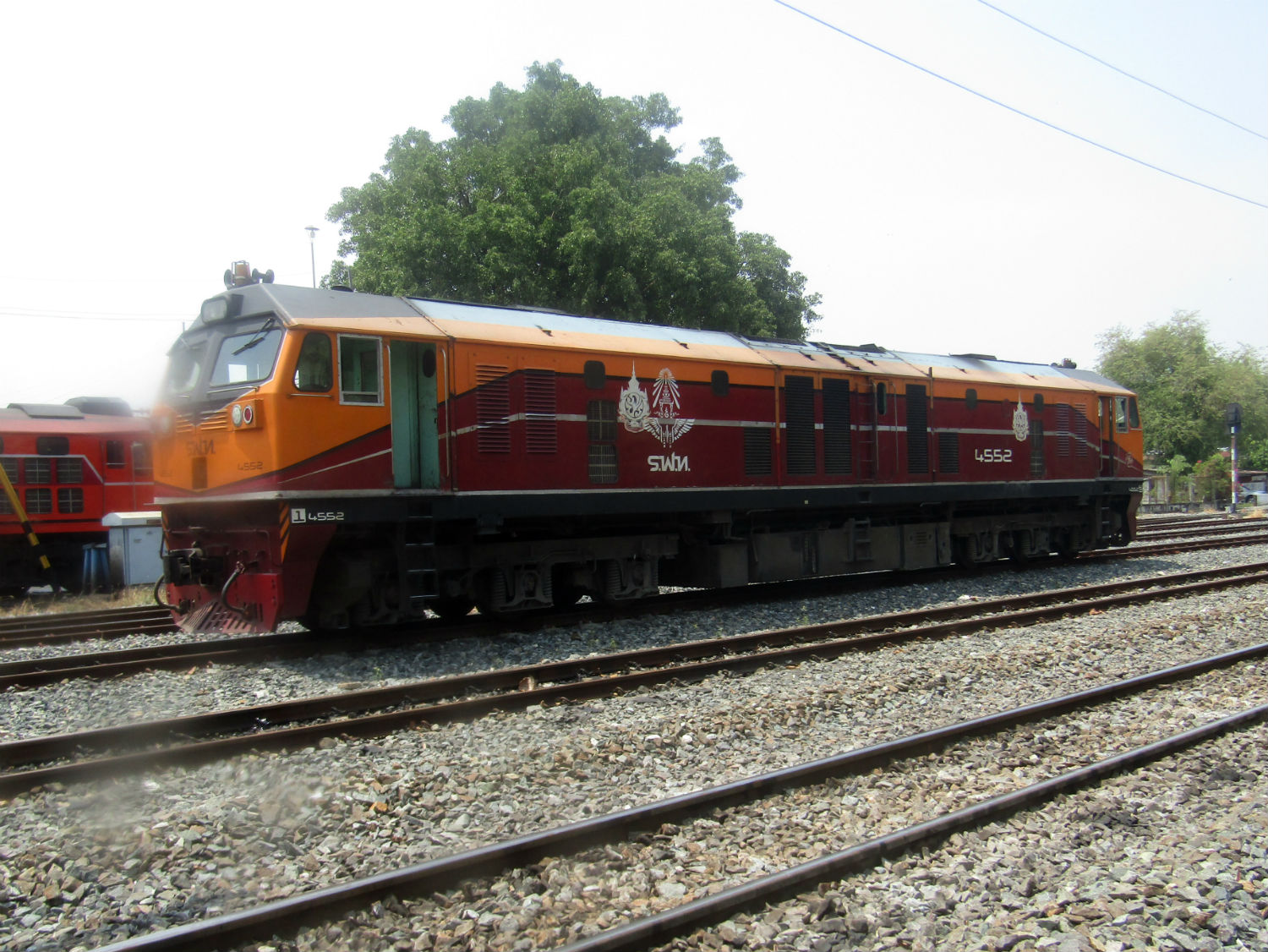
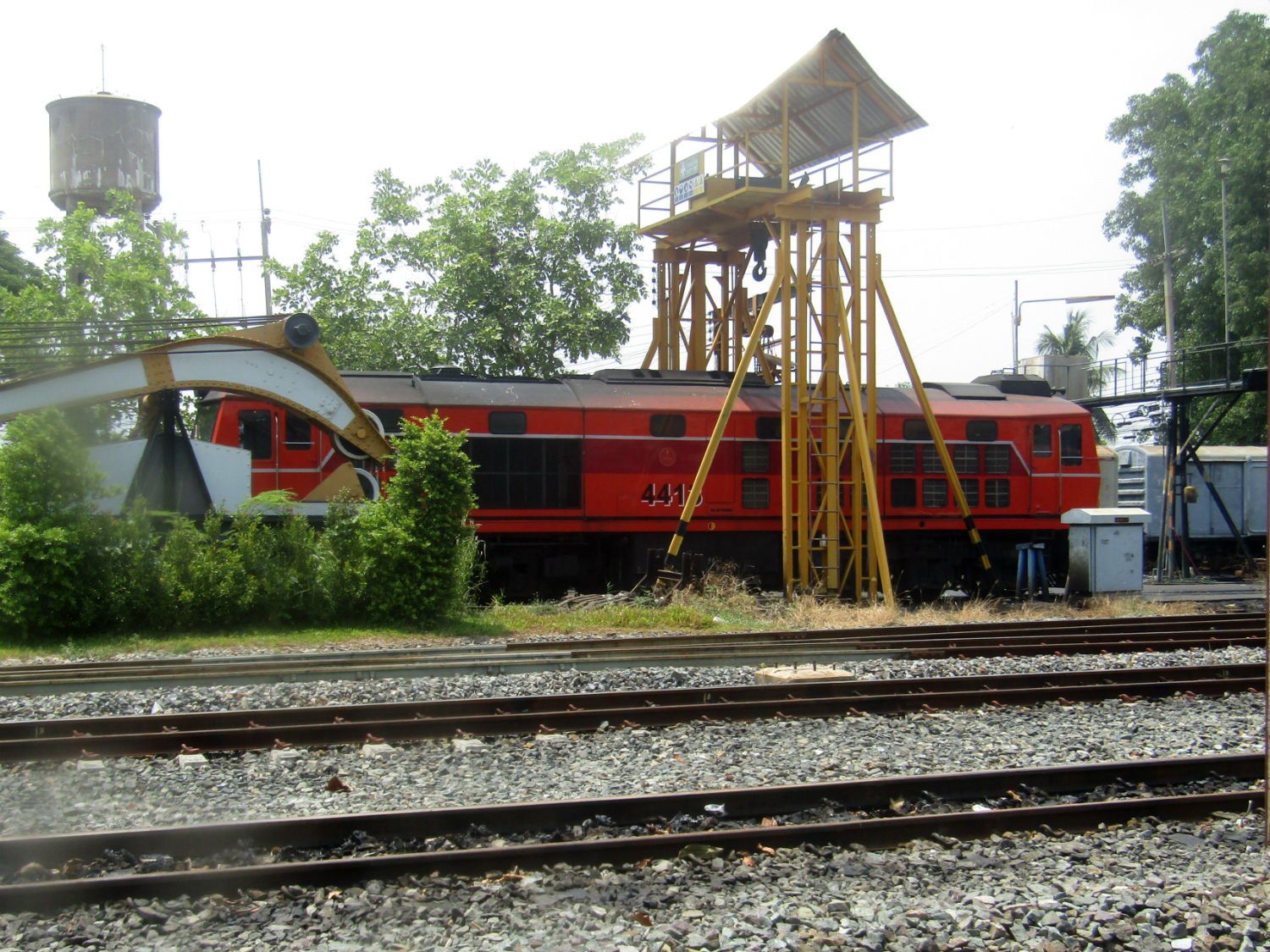 Pak Nam Pho Railway Station, Mueang Nakhon Sawan District, Nakhon Sawan Province
Pak Nam Pho Railway Station, Mueang Nakhon Sawan District, Nakhon Sawan Province
Wat Krieng Krai Klang……..
Wat Krieng Krai Klang is located near the Nan river some 10 kilometres to the northeast of Nakhon Sawan off rural road 225. I suppose I must start here with mentioning monkeys, lots of monkeys, more than I have seen at other temples. They are everywhere grabbing attention away from the temple itself. There is no English sign board that I can find but the architecture appears to be 19th century. Evidence of a brick chedi nearby could date the origins of this temple far earlier.


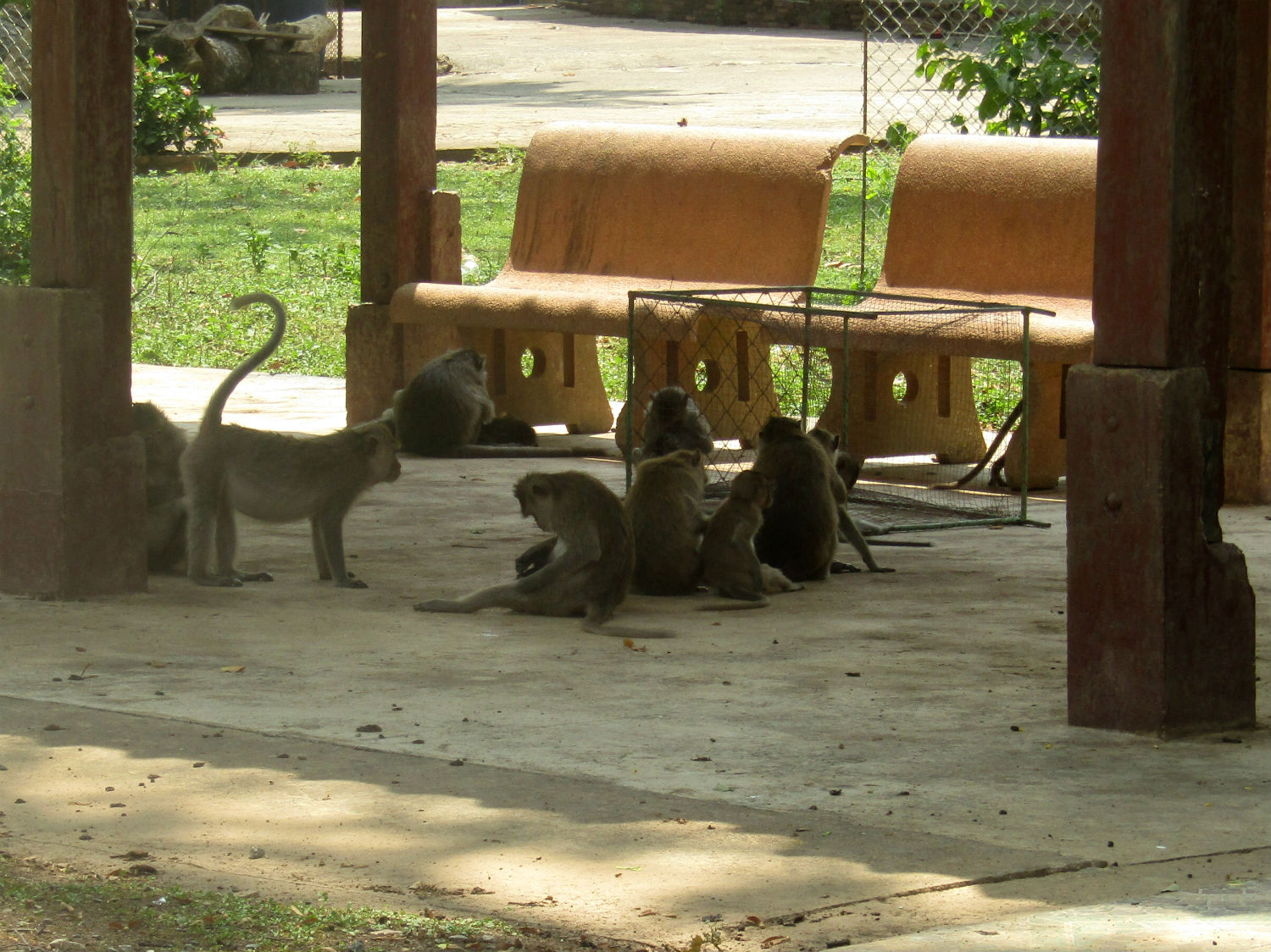

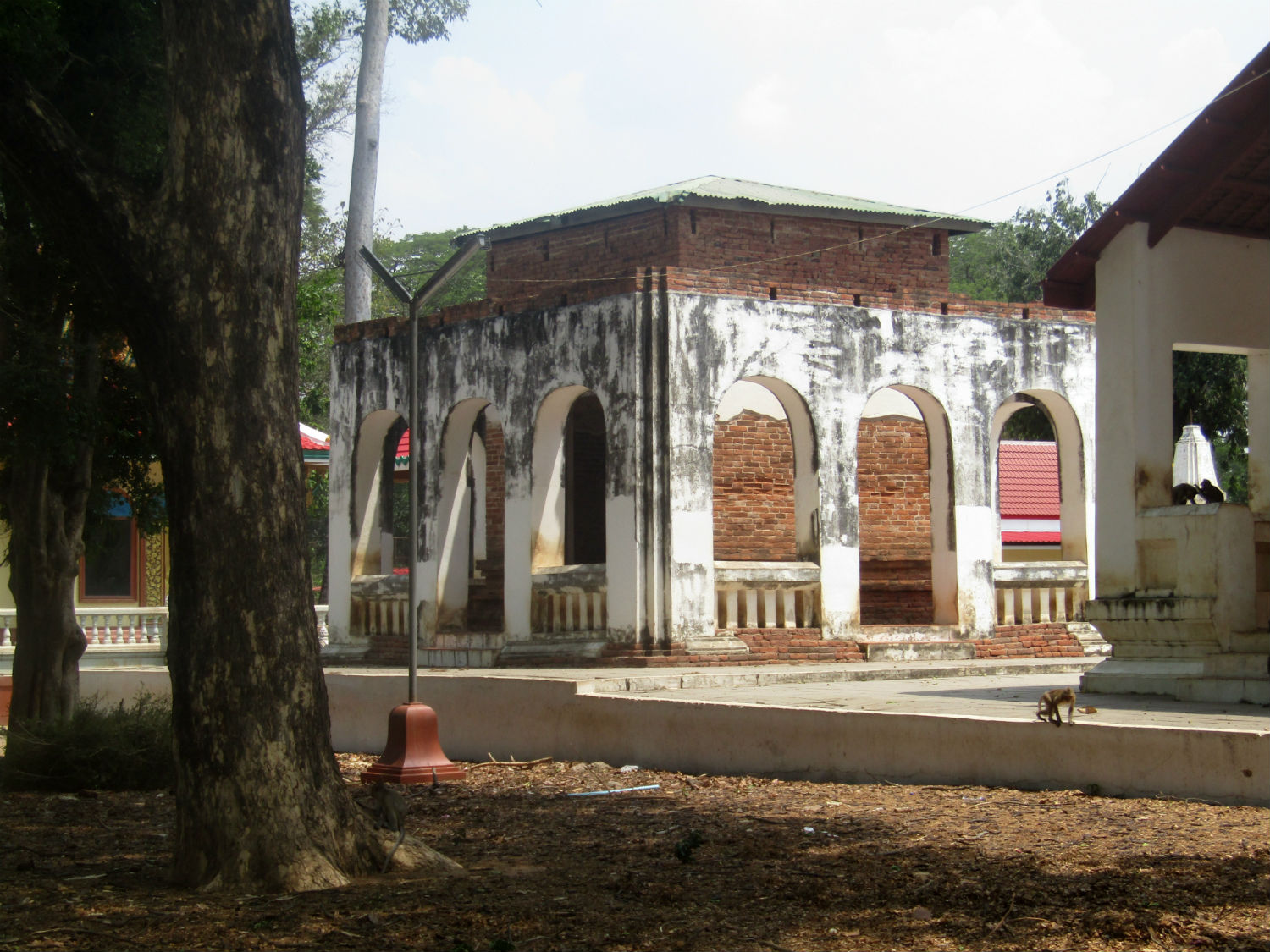
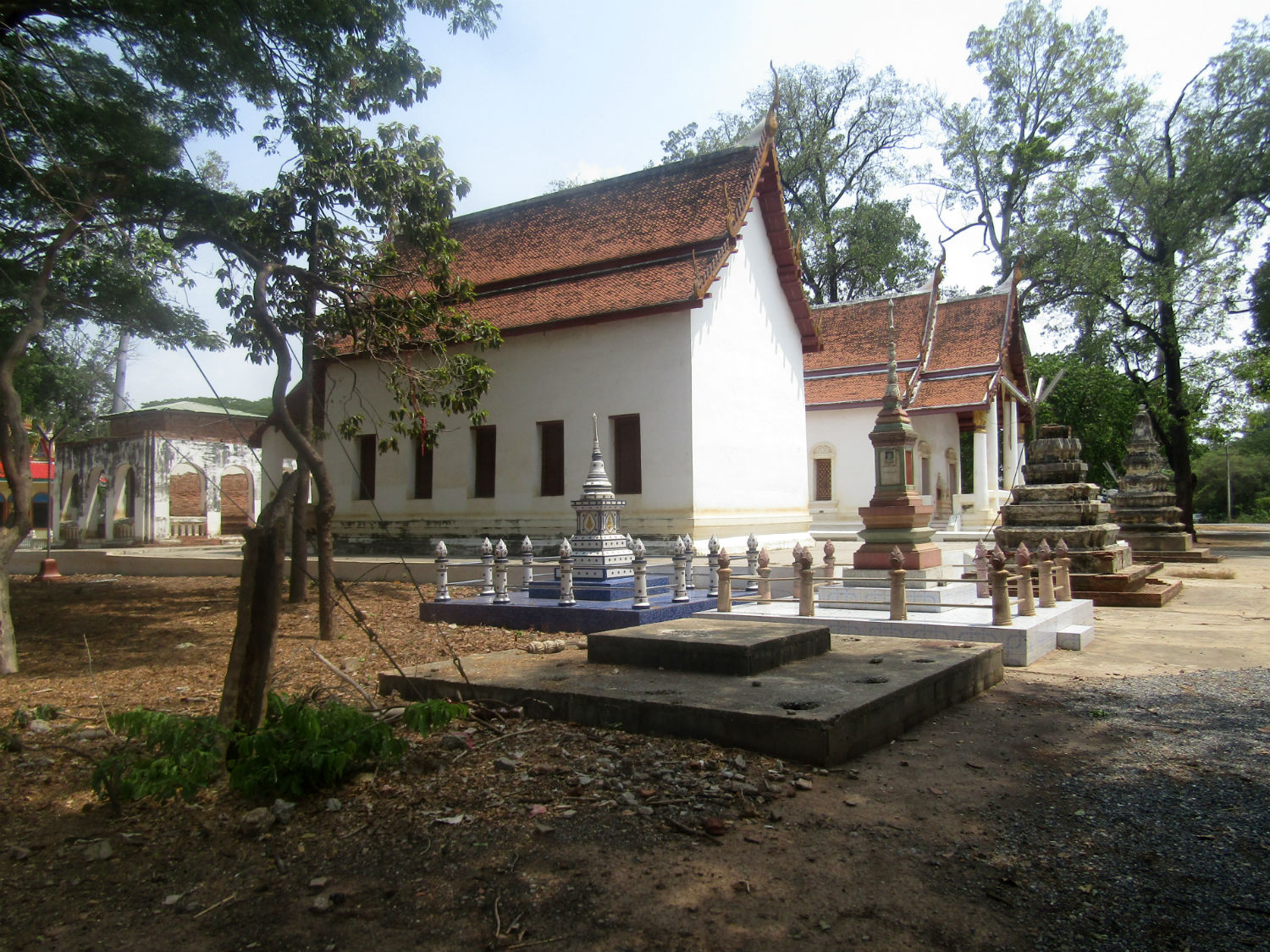 Wat Krieng Krai Klang, Mueang Nakhon Sawan District, Nakhon Sawan Province
Wat Krieng Krai Klang, Mueang Nakhon Sawan District, Nakhon Sawan Province
Chum Saeng……..
From this point, sites in or near the city have been covered as best I can and I need to travel further afield for more sites in this province. Now another of Katoon’s choices comes into play as she heads northeast, a half-hours drive away. I confirm that there are a couple of sites in this district that interest me but are not on any list of attractions I’ve yet come across.
Chum Saeng Railway Station…….. Chun Saeng is a bustling market town boosted by the passage of the Northern Line linking Bangkok with Chiang Mai. When we park up on the opposite side of the station I can simply walk across the lines to establish if any services are due. By the number of passengers waiting there would seem to be. However the first sign of life occurs within minutes of my arrival but it’s not a passenger service; it’s an oil train heading south. It rumbles into the sidings and stops. Remembering that the Northern Line is single track most of the way, these crossover points are vital and Chum Seang seems to be one of the most important. The arrival of a freight train stopped at a signal can only mean that a passenger service is due. I have to wait whatever happens as my route back across the line is blocked. Then just when I’m about to enquire when the passenger service is due I’m alerted to another oil train arriving on the next track to the first; this time heading north. Now my passage is really blocked but it can’t be long before the passenger service arrives. As the bell rings and the station staff appear, I look south and witness the arrival of a DMU sprinter service from Bangkok to Sila-At (Utharadit). The sprinter soon clears the platform and the southbound oil train can depart followed five minutes later by the northbound oil train presumably heavy with fuel oil. As I now cross over the line, I can reflect on this unusual amount of traffic and the interest it has generated.
Chum Saeng Railway Station…….. Chun Saeng is a bustling market town boosted by the passage of the Northern Line linking Bangkok with Chiang Mai. When we park up on the opposite side of the station I can simply walk across the lines to establish if any services are due. By the number of passengers waiting there would seem to be. However the first sign of life occurs within minutes of my arrival but it’s not a passenger service; it’s an oil train heading south. It rumbles into the sidings and stops. Remembering that the Northern Line is single track most of the way, these crossover points are vital and Chum Seang seems to be one of the most important. The arrival of a freight train stopped at a signal can only mean that a passenger service is due. I have to wait whatever happens as my route back across the line is blocked. Then just when I’m about to enquire when the passenger service is due I’m alerted to another oil train arriving on the next track to the first; this time heading north. Now my passage is really blocked but it can’t be long before the passenger service arrives. As the bell rings and the station staff appear, I look south and witness the arrival of a DMU sprinter service from Bangkok to Sila-At (Utharadit). The sprinter soon clears the platform and the southbound oil train can depart followed five minutes later by the northbound oil train presumably heavy with fuel oil. As I now cross over the line, I can reflect on this unusual amount of traffic and the interest it has generated.
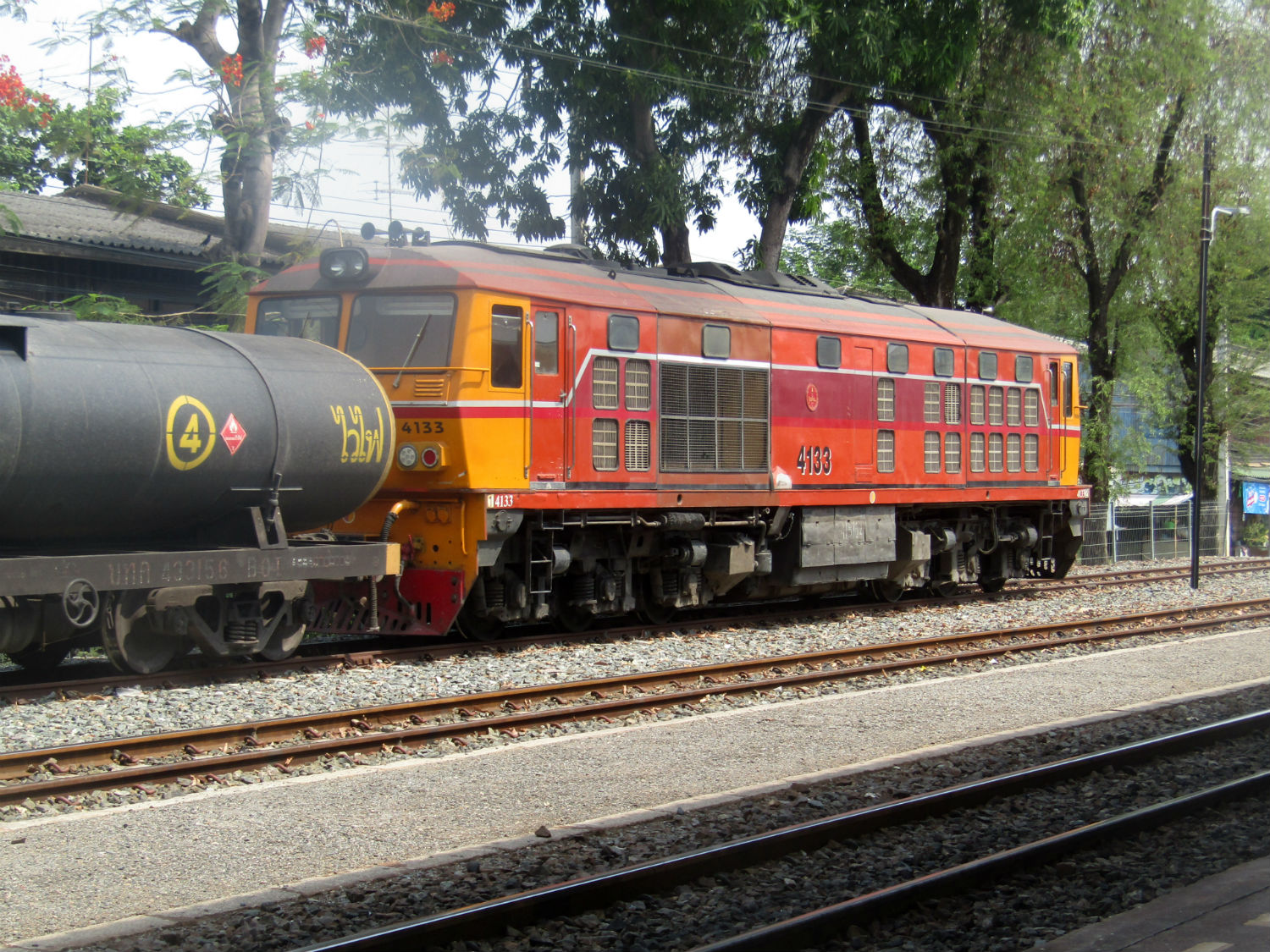


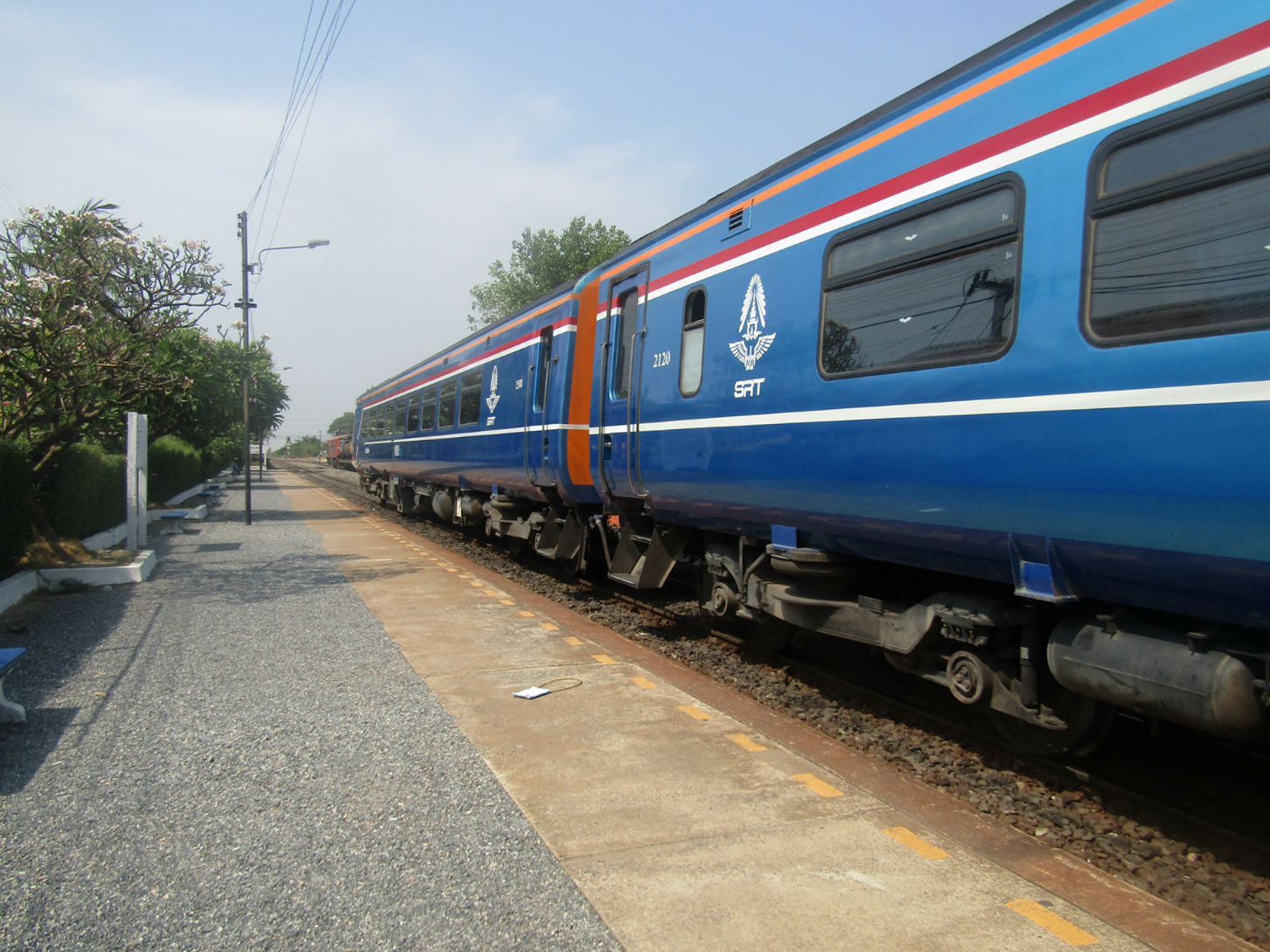
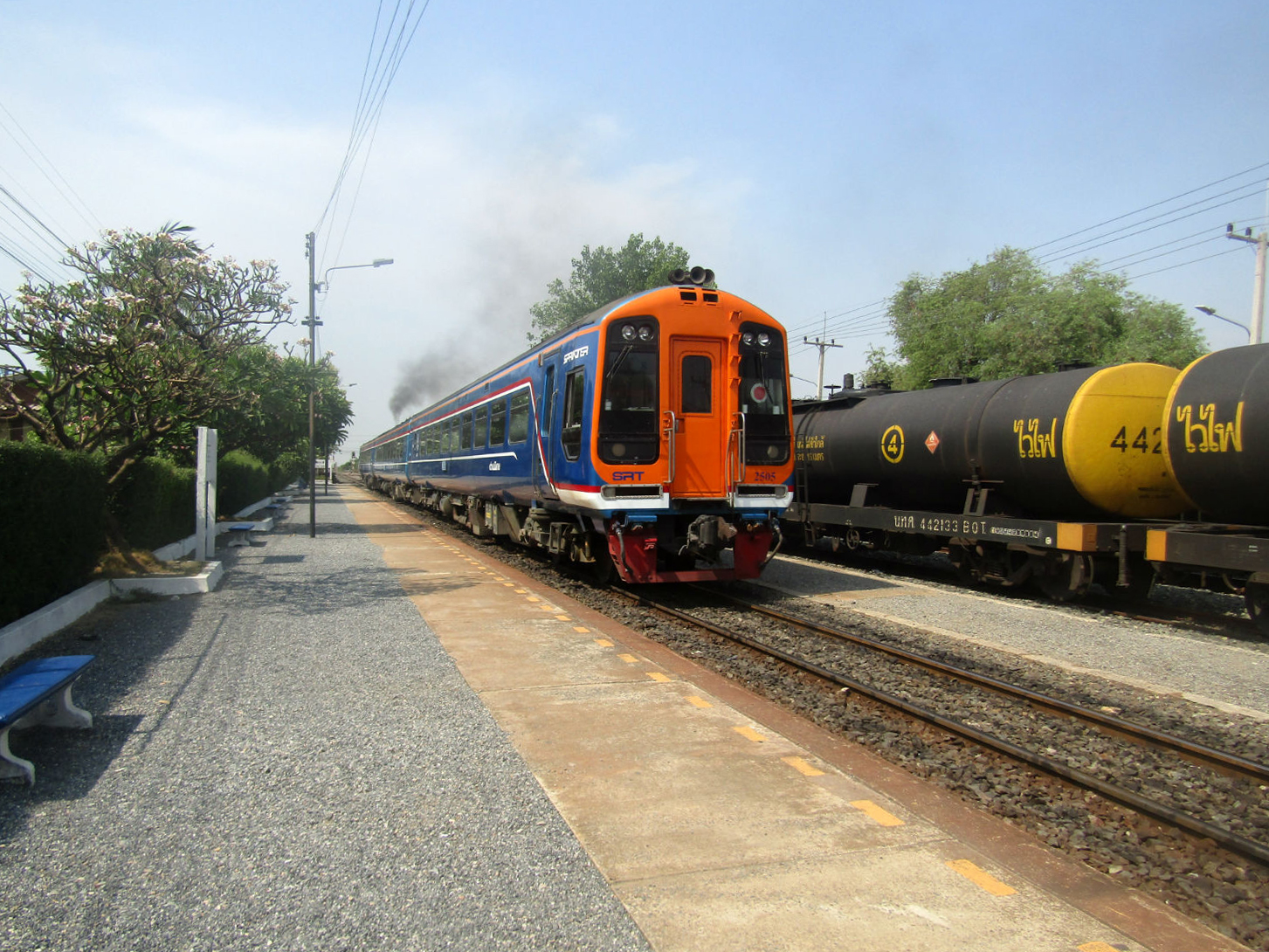
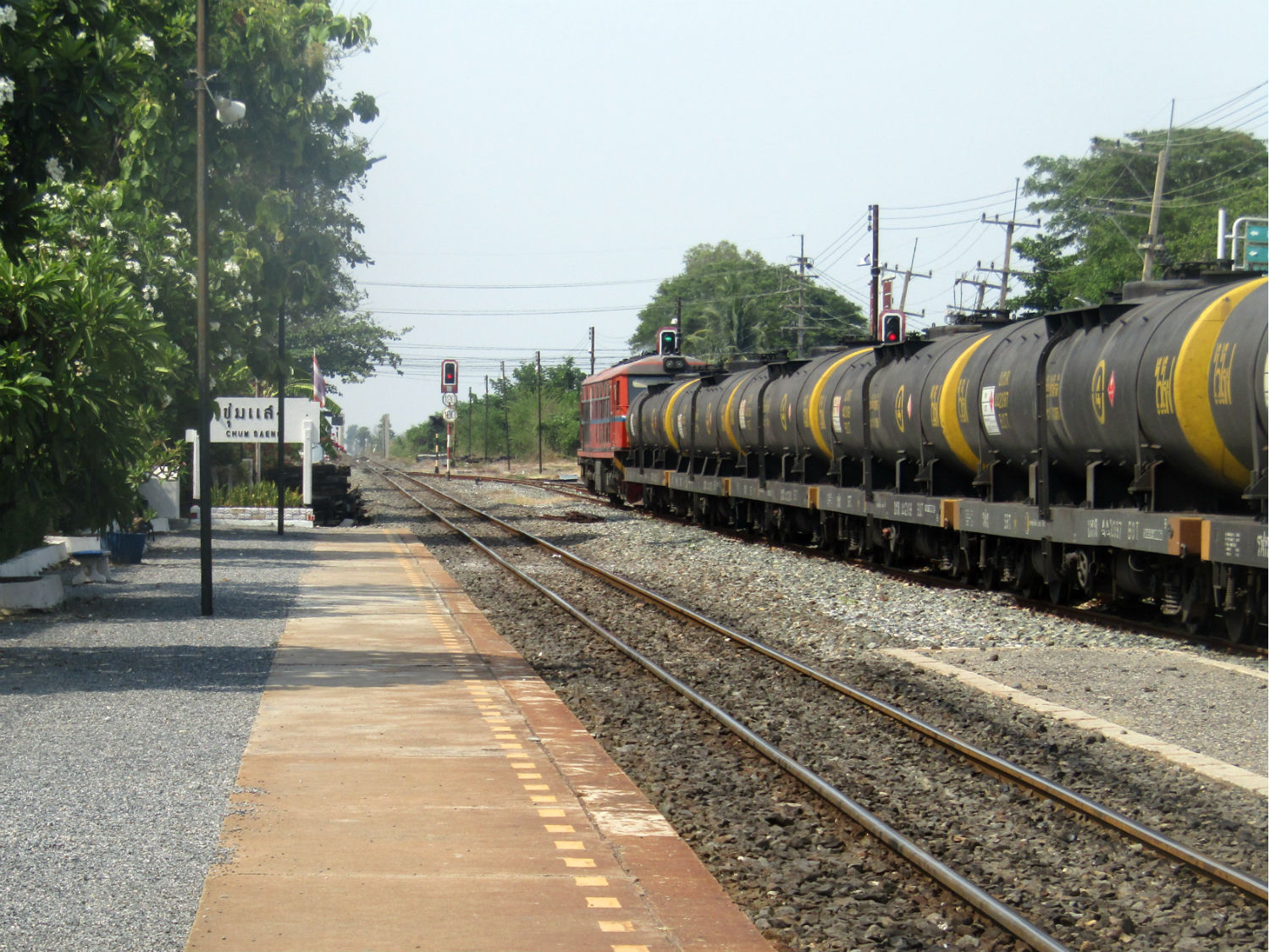 Chum Saeng Railway Station, Chum Saeng District, Nakhon Sawan Province
Chum Saeng Railway Station, Chum Saeng District, Nakhon Sawan Province
Wat Koei Chai Nuea (Wat Boromathat)……..
Now in mid afternoon, I’m not surprised that Katoon has located another temple, the principal reason she wished to visit Chum Saeng. When I identify it on Google Map, I realise that apart from any religious or historical importance the temple might have, there is another reason to visit this temple which is entirely natural. It doesn’t take long for me to scratch my head as to why this temple is not on general lists of tourists sites that I’ve come across and that includes tripadvisor where normally no stone is left unturned.
Wat Koei Chai Nuea is located at the junction of two important river systems, the Nan and the Yom. At this important junction there has been a temple here since the Sukhothai Era some 650 years ago. Since then it has survived the ravages of time though the Ayutthaya, Thonburi and Rattanakosin Eras. What is so exciting about this temple is the amount of detail in English that the abbot has provided in an area not well known to foreigners. When I have something to read at a religious site my interest is dramatically increased. So much detail is available that I cannot start to enter it here but simply record for the moment that the history of this temple, the determination to preserve its heritage, the location at the junction of the Nan and Yom rivers and the crocodile legends attached to that are all powerful reasons to make a detour and visit this extraordinary site. Note that the legend of the crocodile is an interesting read and a museum, sadly not currently open, is within the temple complex.
Wat Koei Chai Nuea is located at the junction of two important river systems, the Nan and the Yom. At this important junction there has been a temple here since the Sukhothai Era some 650 years ago. Since then it has survived the ravages of time though the Ayutthaya, Thonburi and Rattanakosin Eras. What is so exciting about this temple is the amount of detail in English that the abbot has provided in an area not well known to foreigners. When I have something to read at a religious site my interest is dramatically increased. So much detail is available that I cannot start to enter it here but simply record for the moment that the history of this temple, the determination to preserve its heritage, the location at the junction of the Nan and Yom rivers and the crocodile legends attached to that are all powerful reasons to make a detour and visit this extraordinary site. Note that the legend of the crocodile is an interesting read and a museum, sadly not currently open, is within the temple complex.




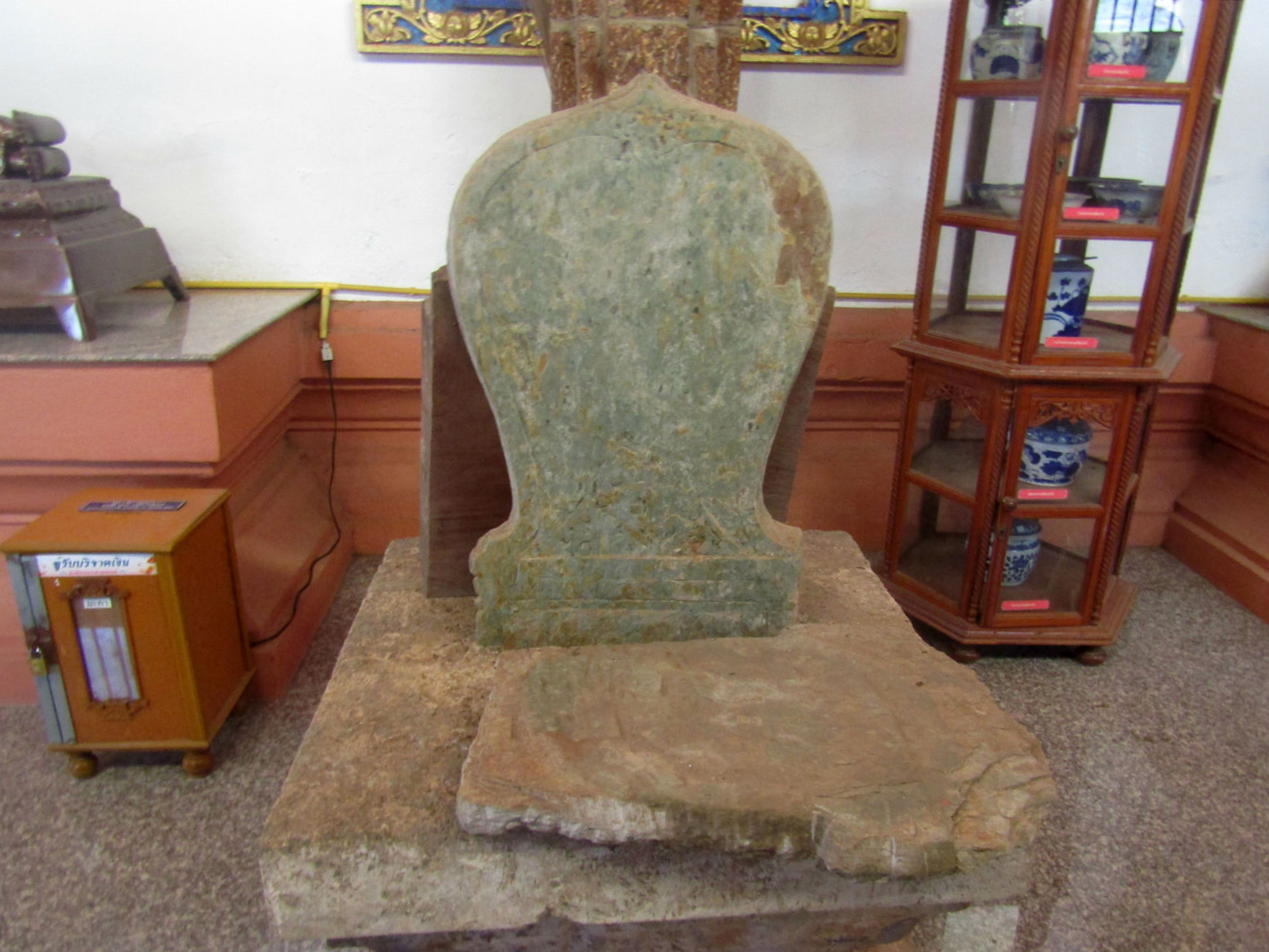
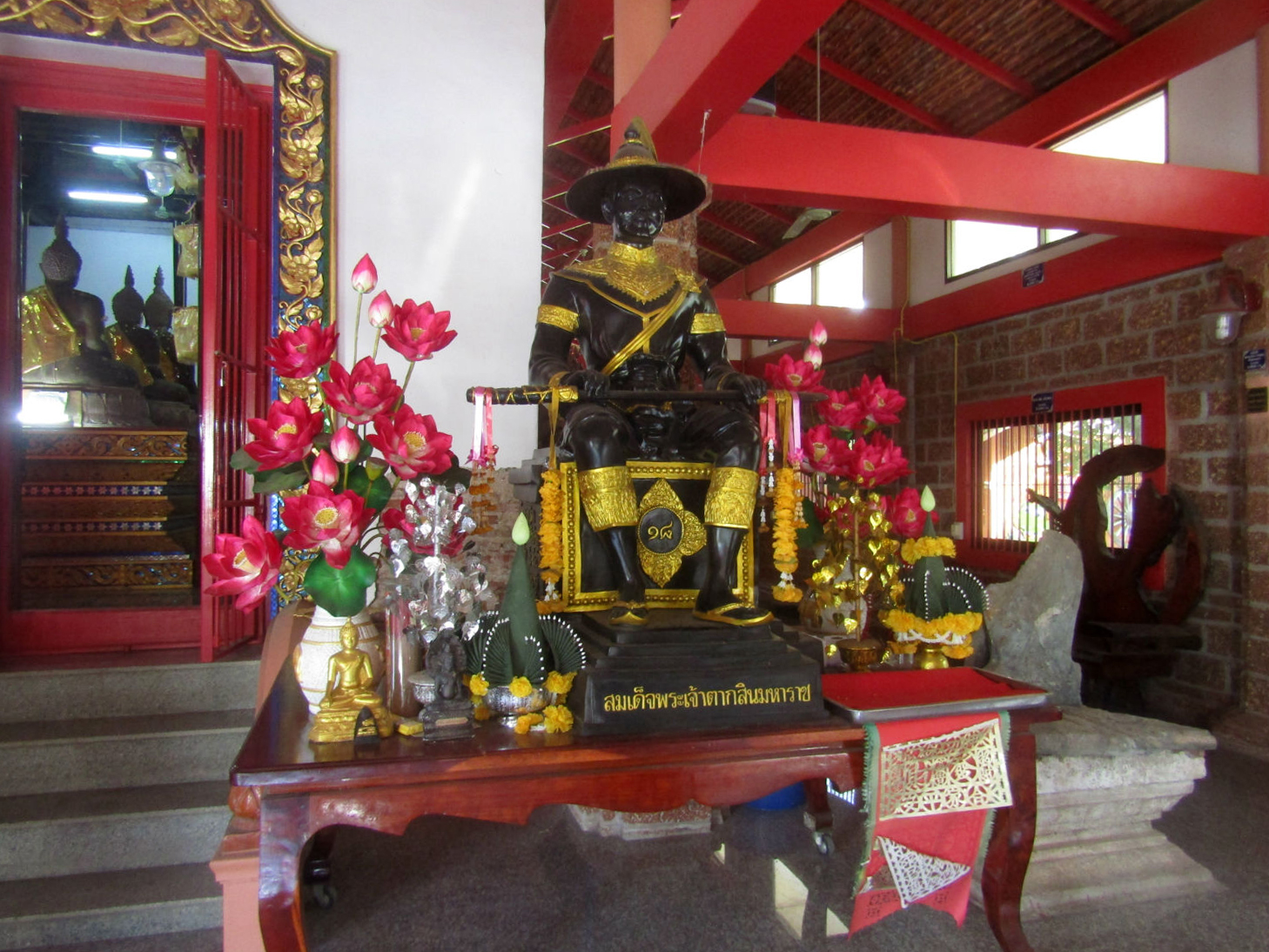
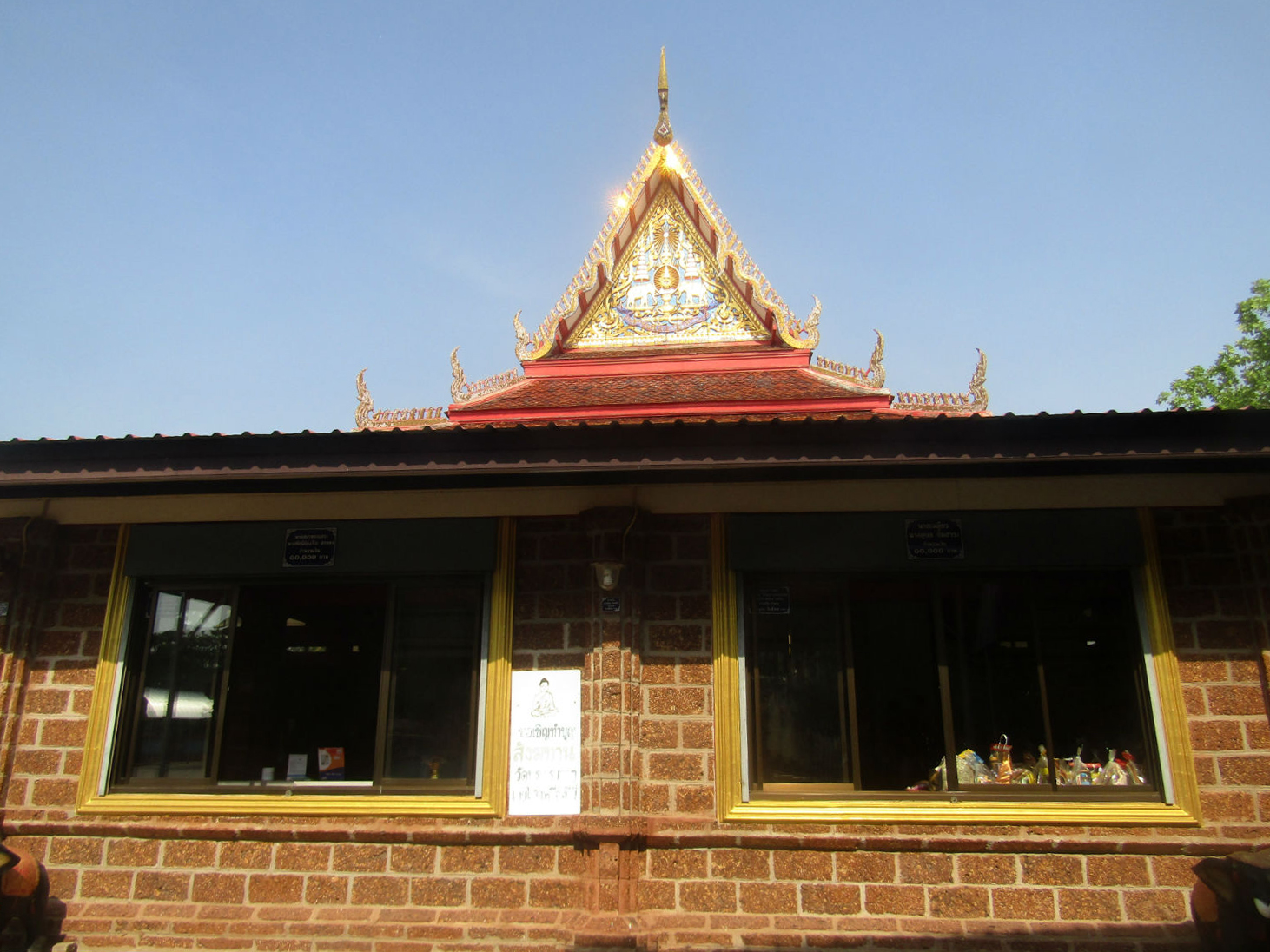

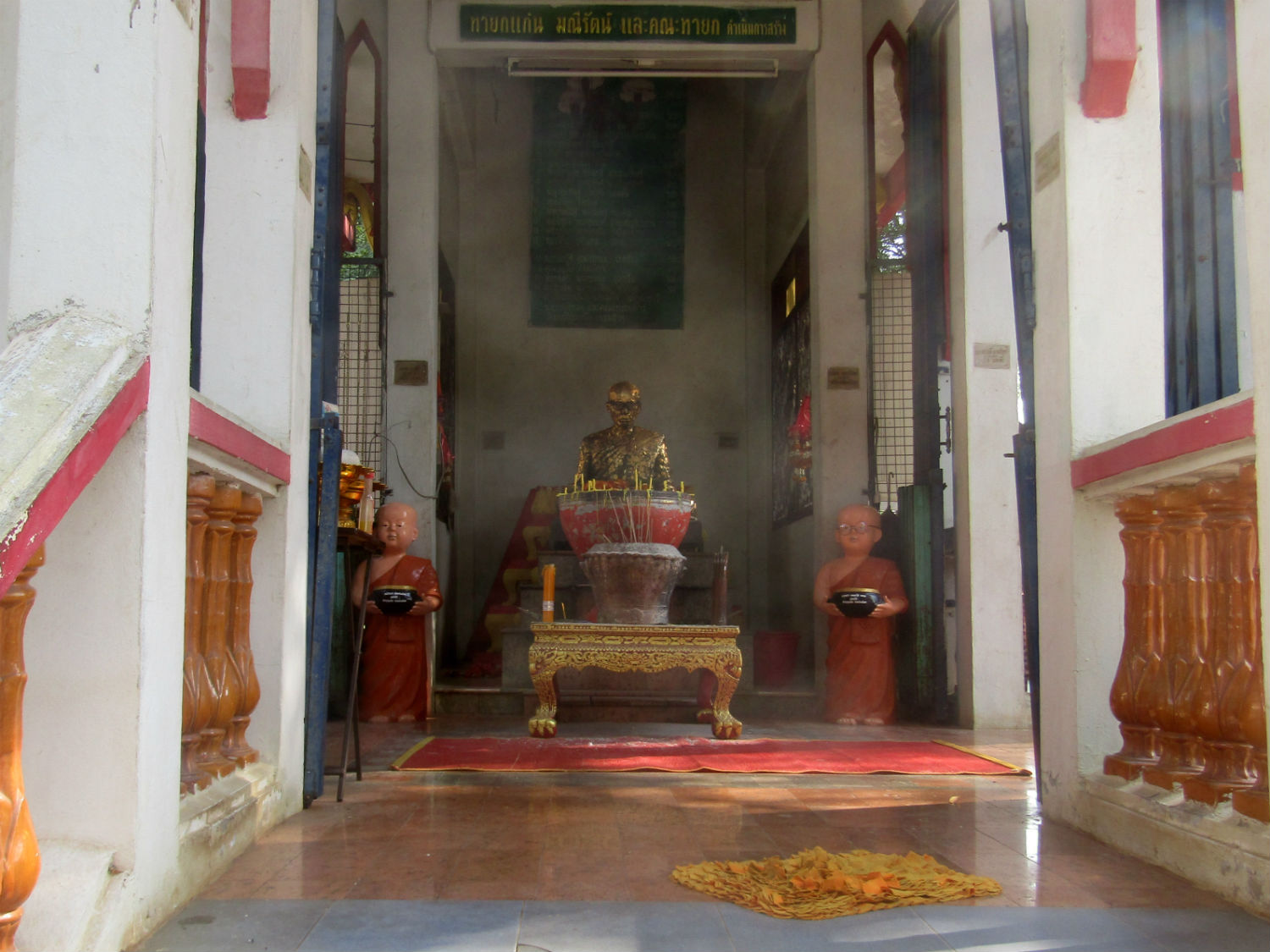 Wat Koei Chai Nuea (Wat Boromathat), Chum Saeng District, Nakhon Sawan Province
Wat Koei Chai Nuea (Wat Boromathat), Chum Saeng District, Nakhon Sawan Province
Nan/Yom River confluence……..
As mentioned Wat Koei Chai Nuea lies precisely at the confluence of these two important river systems, the Nan in turn joining with the Ping in Nakhon Sawan. These three river system allow drainage of the entire northern region. At the Nam/Yom junction the river levels were much higher in the past and the coast much nearer. Here giant crocodiles were found in abundance creating a serious threat to human life particularly to fishermen. Consequently the temple is nicknamed the crocodile temple.
Those who visit the temple will also note that the colour of the water in the two rivers is different, the brownish colour of the Nan contrasting with the green of the Yom. This is because they pass through different terrain. Still, the mosaic of colours formed at the confluence is most interesting.
Those who visit the temple will also note that the colour of the water in the two rivers is different, the brownish colour of the Nan contrasting with the green of the Yom. This is because they pass through different terrain. Still, the mosaic of colours formed at the confluence is most interesting.

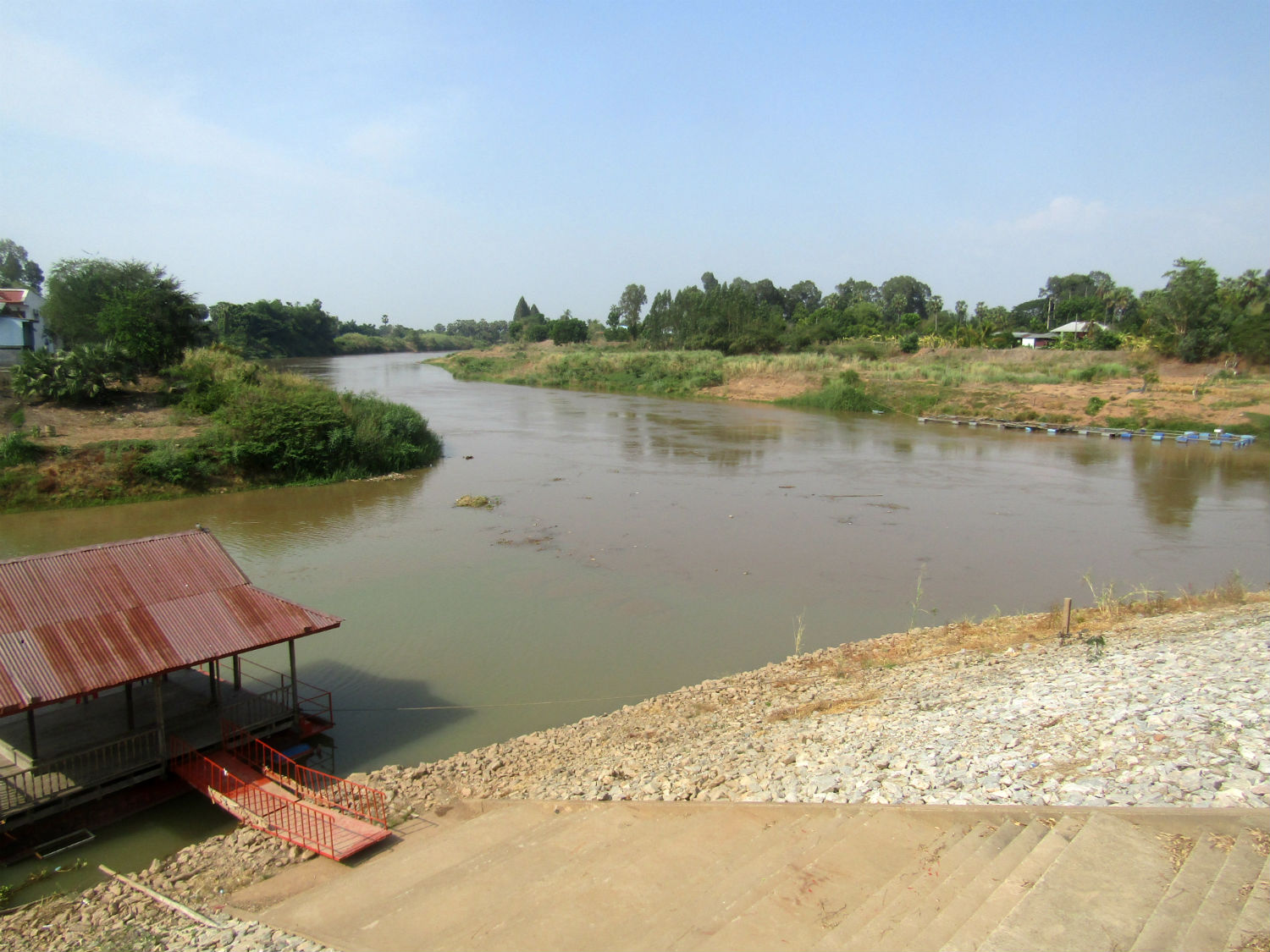
 Nan/Yom River confluence, Chum Saeng District, Nakhon Sawan Province
Nan/Yom River confluence, Chum Saeng District, Nakhon Sawan Province
Finally a great day……..
Leaving Chum Saeng district to head back to Nakhon Sawan leaves us with little time to take in anything else today. Arriving at Maihom Hotel there’s reason to rest a while then with not too many dining options, we end up taking warm food back to the room. Despite a lot of work to get through this evening, I can otherwise report that we’ve had a good if not great day in the field which has exceeded all expectations. Next Page.